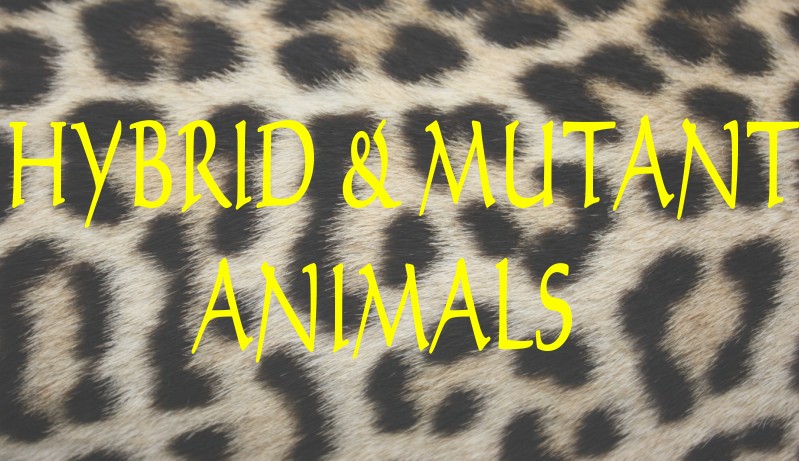
|
TIGON (TION, TIGRON, TIGLON) |

The offspring of a male tiger and a lioness is a tigon (alternative names are tion, tigron or tiglon). Tigons have no scientific name, but Panthera tigris X leo has been posited. That lions and tigers can be crossbred is well documented. According to AP Gray in Mammalian Hybrids, the basic colour of lion/tiger hybrids is pale ochre to rust yellow-brown, more intensive than in the lion, but paler than in the tiger and with tiger striping. The mane of the males develops late and is shorter than that of a lion. L Reisinger(1929) reported a male liger as weighing as much as both parents together.
In "The Variation Of Animals And Plants Under Domestication" Charles Darwin wrote: "Many species of Felidae have bred in various menageries, although imported from diverse climates and closely confined. Mr. Bartlett, the present superintendent of the Zoological Gardens (18/17. On the Breeding of the Larger Felidae 'Proc. Zoolog. Soc.' 1861 page 140.) remarks that the lion appears to breed more frequently and to bring forth more young at a birth than any other species of the family. He adds that the tiger has rarely bred; "but there are several well-authenticated instances of the female tiger breeding with the lion [liger]." Strange as the fact may appear, many animals under confinement unite with distinct species and produce hybrids quite as freely as, or even more freely than, with their own species." The voluntary hybridisation of some zoo animals is also referred to as hypersexuality.
|
Late 1920s/early 1930s: A keeper introduces a lion cub to a tiger cub in a hamper with a view to them sharing a cage. The young tiger is described as "furious" when the lid is raised while the young lion is merely curious. At the time, mixed exhibits were considered most attractive. In Germany, Hagenbeck accomplished mixed exhibits of lions, tigers, bears and hyenas. |
Late 1920s/early 1930s: A lion and tiger accustomed to sharing a cage, though the relationship was described as mutual tolerance rather than friendship. |
Tigons are currently rarer than ligers. It is suggested that male tigers find the courtship behaviour of a lioness too subtle and may miss behavioural cues that she is willing to mate (though lionesses actively solicit mating). It is more likely that their smaller size makes them less attractive exhibits than ligers. This is borne out by the fact that in the 19th century and early 20th century, tigons were more common than ligers. An adult tigon is often smaller than either a lion or tiger though some have attained or exceeded the size of the smaller parent. They may be less robust than either parent. There is less interest in them because they are less spectacular than ligers. The actual size and appearance depends on which subspecies are bred together and how the genes interact. The smaller size of the tigress compared to the lion means that cubs may be stillborn, premature (there isn't enough space in the womb for them to develop any further) or sickly and not able to survive. Premature birth can lead to health problems in those that do survive.
EARLY REPORTS OF TIGONS
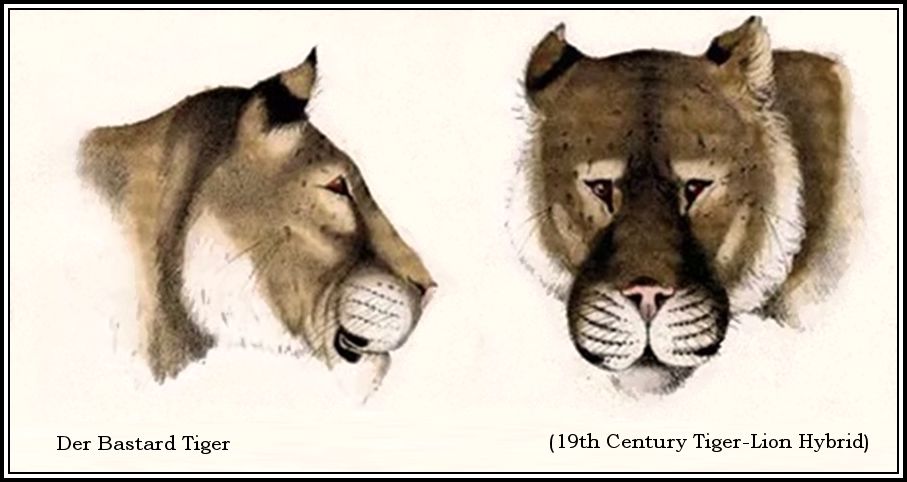
The image below shows a lioness, supposedly with lion cubs, but they are suspiciously well striped. As many drawings of this time were of captive animals, could these be early tigon cubs?
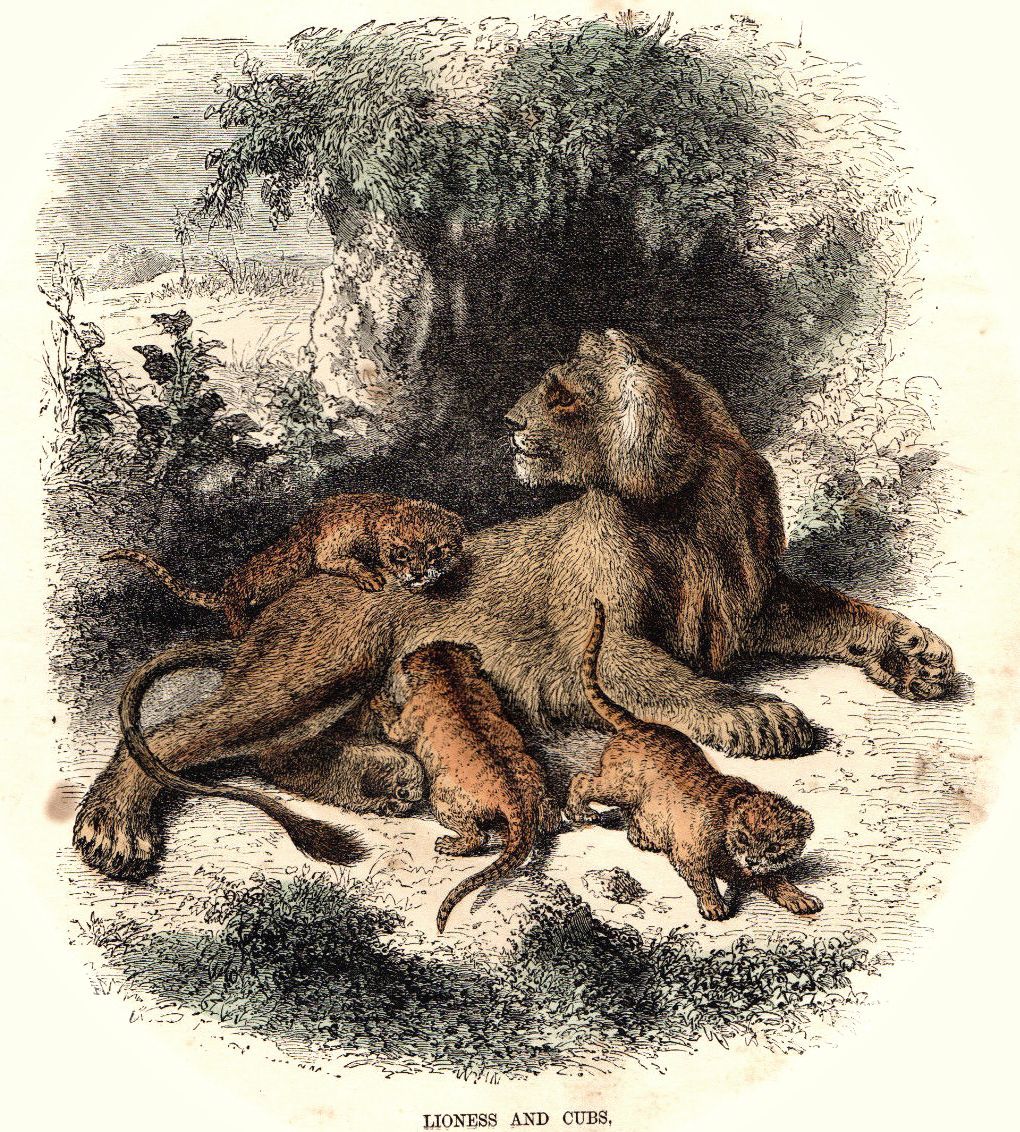
Tiger crosses in captivity have been common for centuries. There is a recorded cross-breeding in India which dates back to 1837 when a tigon was presented to Queen Victoria from the princess of Jamnagar (an Indian state). The first record of tigon breeding in Britain came from a touring circus in the 19th Century. They had a tiger and a lioness which produced litter after litter of hybrid cubs. Queen Victoria saw the circus at a command performance at Windsor and the latest litter of hybrid cubs was shown to her.
BABY ANIMALS IN THE NEW YORK ZOO. The Saint Paul Globe (Minnesota), 3rd October 1902, pg 6.
A unique christening will be that of two baby lions, to baby tigers, two infant hybrids, half-lion and half Bengal tiger . . . the most interesting of the baby family and the favorite of visitors and keepers are the hybrid cubs, born last June at Manhattan beach to Juliet, the performing lioness, and Rajah, the man-eating Bengal tiger. The cubs are little fellows, gentle as kittens and quite as playful. Their coats, which are long and shaggy, are pale fawn in color, with black stripes. They are perfectly harmless and will remain so while their teeth are small and their claws short. Six months is the usual babyhood of these animals.
THE LION TIGERS. HYBRIDS THAT ARE FIERCER THAN THE JUNGLE S FIERCEST. The Meriden Morning Record, 9th July 1903, pg 2.
Students of natural history will have a chance to study lion and tiger hybrids in the animal department of the Walter L. Main enormous shows . . . Although the possibility of breeding lion and tiger hybrids in captivity has long been known, it has never been so successfully accomplished as in the winter quarters of this show over a year ago last winter. Then it was that a handsome Bengal tiger, Bob, was mated with an African lioness Rose. Bob is considered the finest specimen of the tiger family in captivity. His height across the withers as he stands erect is fifty-two inches, and from the tip of the nose to the tip of the tail is ten feet nine inches. He weighs 474 pounds, Rose is a handsome lioness but a trifle lighter in weight and not as long in body by a number of inches. She was selected because she had previously proved such a good mother. A year ago last winter she became the mother and Bob the father of four cubs, and even at birth the difference was noticeable.
While the mother was favored, the shape and markings of the father predominated. It was evident that Rose had noticed this, too, and like a hen who had hatched out duck eggs, was not thoroughly satisfied. Animal Trainer Winner, as well, noticed uneasiness of Rose, and was feared lest she might destroy them. He secured a large St. Bernard dog mother who had recently been deprived of her pups [euphemism for puppies being destroyed at birth], and, taking the cubs from Rose, succeeded in getting the dog to adopt them. She proved equal to te task, and, with the aid of a nursing bottle, the four cubs were matured, and are now perfect in shape and health. They are much larger than any lion or tiger of the same age, and more intelligent.
There are two males and two females. All are striped the same as a tiger, but on the males the shape of the lion heads is conspicuous. With the males the mane is absent, although this does not make itself conspicuous until the age of three years. Mr. Winner says that at one year it should be notices, and he predicts that none will appear on the hybrids. It is expected that they will inherit the fierceness and cunning of both mother and father, and were they in their native element they would unquestionably be the finest animals in the jungle. Mr. Winner, who is authority on animals and their habits, says that in-breeding now between the hybrids will result in domestication to such an extent that in time they will be as docile as the common house dog.
FATHER IS A TIGER; MOTHER A LIONESS. The Tacoma Daily News (Washington), 31st July 1906, pg 6.
Only Hybrids of the Kind have Proud and Jealous Mother at Brighton. Julie is mighty proud these days, and mothers and children who call on her at Brighton Beach are captivated by the beauty of her bouncing twins. Julie is a forest-bred lioness, and the twins are ten days old. In his cage nearby in Ferari s Trained Wild Animal arena, Rajah, Bengal tiger, father of the twins, watches his offspring with jealous eye. They are the first hybrids ever born in this city . . . The twins are growing with amazing rapidity. Their coats, fluffy as a lamb s fleece, have a black stripe down the back and their shapely ears are tipped with black. These are marks handed down by their tiger father. In other respects they favor the mother.
The best known of these early tigons was Ranji, a huge male who was bred by Prince Ranjitsinji, Maharajah Jam Sahib of Nawangagar and presented by him to the Zoological Gardens in Regent's Park in 1924. Mr. Frohawk was commissioned by The Field to sketch Ranji. He found him shy and said "The hybrid favors [resembles] the tiger rather than the lion in the shape of the body and head and it is particularly interesting to note that although the creature is a male, the mane is not larger than that possessed by some tigers and there is at most a small tuft at the end of the tail. The coat, however, is tawny and entirely lacks the reddish-orange hue characteristic of all tigers except those of the colder regions of central Asia. The stripes, nevertheless, although comparatively faint are clearly traceable and the lower parts of the body are whitish as in tigers."
Another report was printed in the Illustrated London News, 14th June, 1952: TIGONS AND LIGERS. By Maurice Burton, D.Sc. IN the late 1920's, a tiger-lion hybrid was exhibited at the London Zoo. There was, if I remember rightly, a good deal of publicity given it but that this mostly centred around the speculation as to whether it should be called a tigon or a liger. The receipt of the photographs reproduced on this page recalled this, now, historical event, and it seemed worthwhile going into the question of hybrids between these two large cats. The literature on the subject is not extensive, and one of the best descriptions and analyses is that given by Pocock in 1935, after having examined the remains of the hybrid already referred to after its death a few years previously. He pointed out then that: Although lion-tiger hybrids have been repeatedly bred for over a century, no statistics have been kept to show the incidence the parents characters upon the offspring.
The Zoo hybrid of the 1920's was the offspring of a tiger and lioness, born in India and presented by H.H. the Jam Sahib of Nawanagar to the Zoological Society of London. Pocock found the mixture of parental characters to be distributed as follows. The lion ancestry was shown in the presence of a mane, a nearly uniform, buffish-tawny skin, with no sign of the orange ground-colour of the tiger, a tail-tuft which, although small, was as large as in some normal lions, and an almost complete suppression of stripes. There were faint stripes to be seen, but these were no more distinct than in some East African lions. The tiger characters were seen in the shape of the head and body, the general absence of dark tips to the hairs which are so characteristic of lions, an indistinct black dorsal stripe, a few thin blackish stripes at the tip of the tail, and the colour of the ears. These last were jet black, with a large tawny patch, instead of the usual white patch of the typical tiger, running to the outer edge near the tip of the ear. (According to the Aberdeen Press and Journal, 24th June 1924, when the hybrid was on display, its father was known to have been a lion, and the mother a tiger.)
This is a summary of the only detailed account we have of these hybrids. In 1902 Cornish recorded a hybrid from a lion-tigress cross bred by Hagenbeck and in the same year Menegaux recorded from Calcutta the result of a similar cross which included several offspring showing the usual mixture of characters but with stripes present in each case. In 1937 Eifrig reported upon some tiger-lioness hybrids he had seen in Dresden Zoo six years earlier. When he inspected them they were one-third grown, and all were like a tiger in the pattern of the coat. This pair of parents had had, apparently, two or three similar families, but no details were given of them. Eifrig also set on record, at the same time, that there was then a family of hybrids from a lion-tigress cross at the Munich Zoo which had shown when first born the stripes of the tiger as well as the spots of the young lion. He also reported that their voice combined the grunting of the tiger with the long-drawn-out cry of a lion, so that it came to resemble the voice of a leopard.
The story leading up to the present family of hybrids, from a tiger-lioness cross in the private menagerie of H.M. the Sultan of Morocco, in Rabat, is worth setting on record. It was noticed that the tiger and the lioness seemed to be on friendly terms, so their cages were brought together and the two animals given free access to each other s cage. Not only did the two settle down on amicable terms, but in time the lioness gave birth to four cubs. When first born, they resembled lion cubs in general features, but later developed the stripes of the tiger well as the heavy fore-limbs.
One of these cubs broke its back while playing, a few days after it was born. Later, one was exchanged for a Bengal tigress with the Ben Amar circus, and one was presented to Professor Urbain, of the Vincennes Institute in Paris, who, with his colleague M. Rinjard, published a very brief note on the animal in 1950. The fourth, Bent Kouigher by name, is still the pet of the Sultan s menagerie. In all four, the characteristics of both parents seem to hve been fairly well mixed. Although the product of a tiger-lioness cross, like the one exhibited at the London Zoo years ago, there is more of the tiger in them than in that one. There is no recognisable mane, but there is a distinct cheek-ruff typical of the tiger; the general proportions of both head and body recall those of tiger; there is the small tail-tuft of a lion; and the stripes, although numerous, are not so pronounced as in even the most lightly-marked tiger. The voice is said to be rattling and guttural and to combine the mewing of the tiger with the roar of the lion.
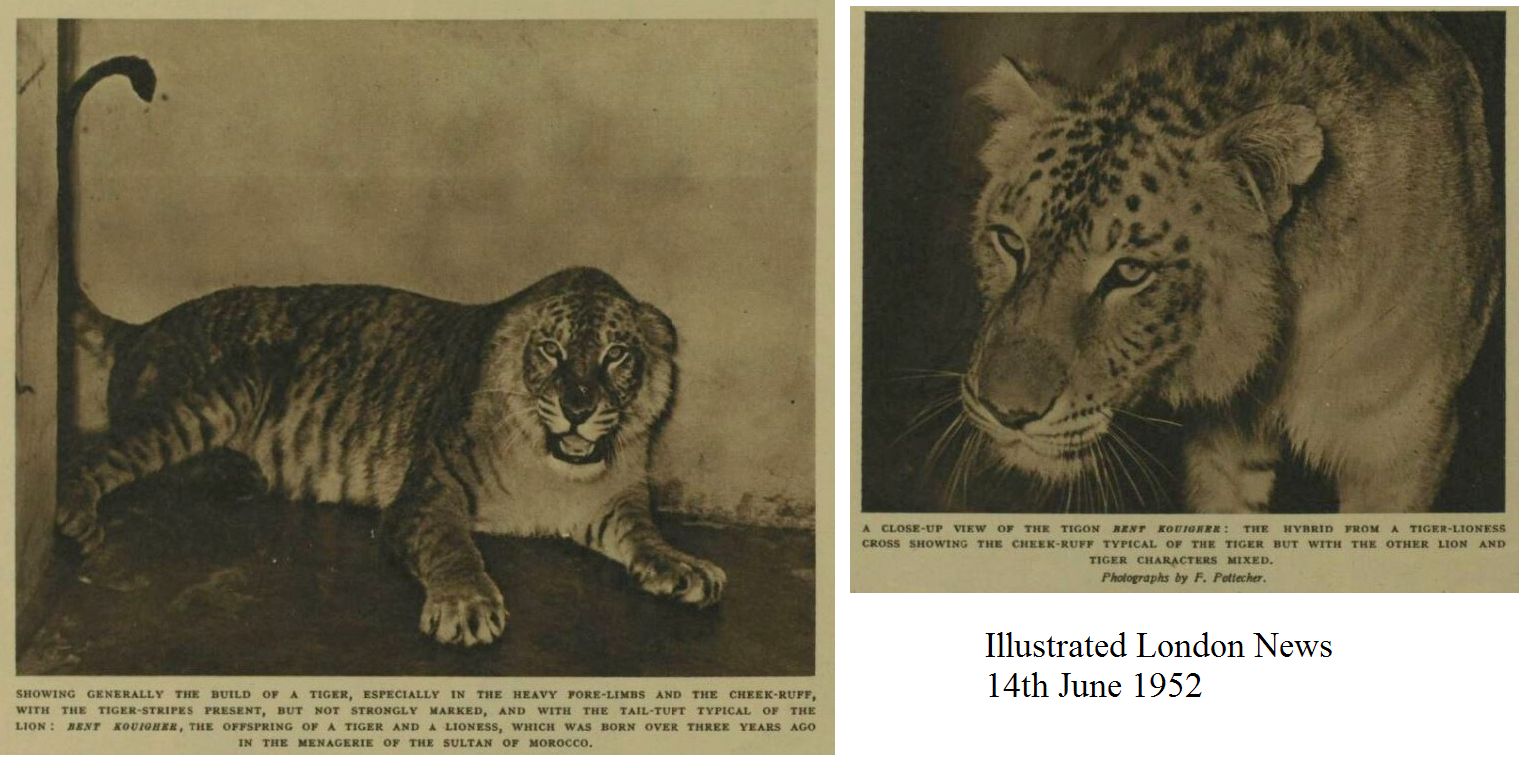
One of the first things to emerge from this brief study is that a lion and a tiger, for all the striking differences between them in the adult, must be very closely related. Thus, when their characters are mixed, as in the hybrids, it requires a specialist like Pocock to sort them out, and even he was obviously in some difficulty in doing so. Moreover, the differences between the two seem to be superficial rather than deep-seated. It is usually stated that the skulls of a lion and a tiger can be readily distinguished, but Pocock showed that this was true only when two or a few were examined, but not the case when a long series of skulls from each species are laid side by side. Furthermore, in seeking to decide whether the skull of the London Zoo hybrid was more lion-like or more tiger-like, the best he could arrive at, after a long series of measurements on it and on a number of lion and tiger skulls, was that the skull of the hybrid was nearest that of the Indian tiger.
Linked with this close similarity, if not actual affinity, between the two species must be noted a readiness to be companionable and to mate. It is not without significance that the parents of Bent Kouigher showed sufficient signs of friendliness to cause their cages to be placed side by side and the doors opened to allow them to come together. In spite of this, however, what little we know of these hybrids clearly shows that in the many instances where, as in zoos and circuses. mixing has been permitted, the union is often fruitless, or the cubs are still-born, or else they fail to survive for long.
The bars to hybridisation, especially in the higher animals, are many. In the wild, the habitat and what may be called the call of the species, constitute the first bar. By the call of the species I mean those features of appearance and tricks of behaviour which two animals of a species have in common and which make them more at home with each other than with a member of another species, no matter how closely related. The second obstacle is the stereotyped behaviour pattern which all species exhibit in their courtship. Normally each step in the unfolding pattern gives the necessary stimulus to the performance of the next step, and as a rule the courtship breaks down if at some stage the appropriate behaviour by one or other partner is not performed. Such gaps can, under abnormal conditions, be bridged, but they usually constitute a barrier. The next obstacle to the hybridisation is, as we have seen, that even if courtship is successful and the actual mating is mechanically successful, there may be no offspring, or there may be offspring which fail to survive. Finally, there is the sterility of the offspring themselves. So far as the ligers [or tigons] themselves are concerned, there seems to be ample proof of this, for all attempts at mating between the hybrid and a normal mate have been completely unsuccessful.
1920s - RANJIT, THE LONDON ZOO TIGON
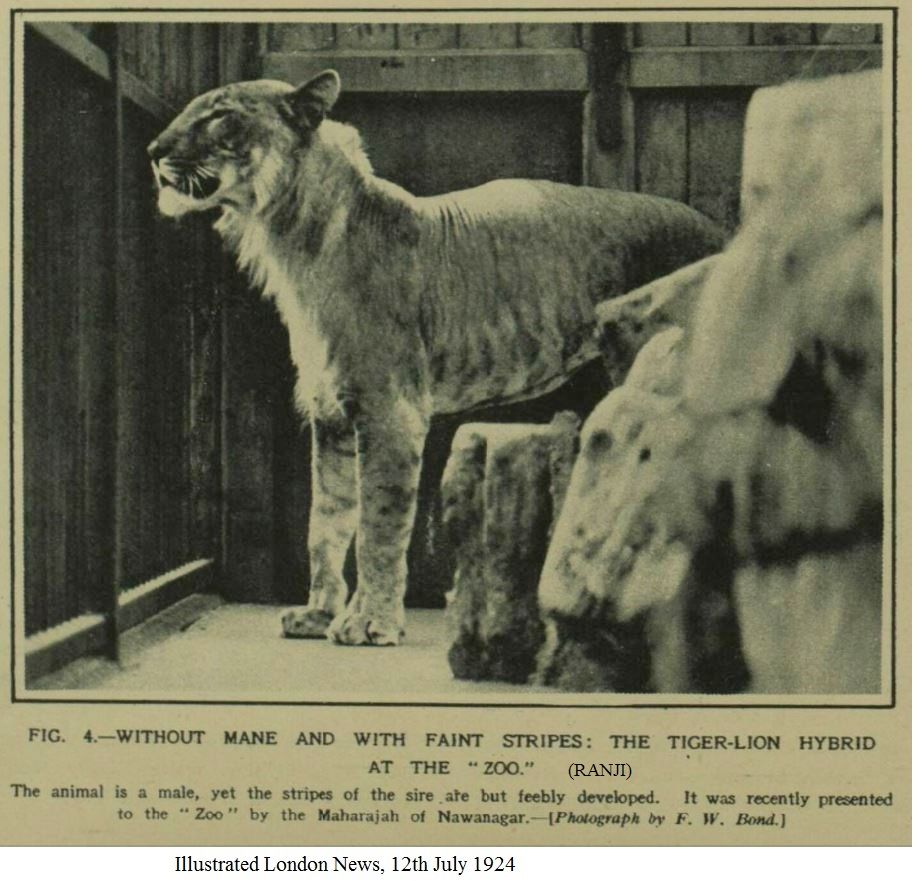
THE LION-TIGER HYBRID. Country Life, 16th August, 1924, pg 267: Sir,- Your picture of the lion-tiger hybrid presented by H.H. the Jam Sahib to the Zoo might well represent what used to be known as the "maneless lion" of Guzerat. There are several records of this animal, which was supposed to be a distinct species of Felis leo. In 1783 Captain Smee of the Bombay Infantry shot eleven of them near Cutch. They were known as the "untia bagh," being camel-coloured. (Proceedings of the Zoological Society). About the same time Sir Charles Malet, then "President" of Cambay, during a hunt in the same vicinity shot one of these beasts, "camel-coloured, and esteemed the fiercest and most powerful of its tribe" (Forbes' "Oriental Memoirs"). I had read in the Abba Dubois' Tours a mention of a similar beast, and when in camp near Cambay fifty years ago the Vaghris told me of an animal honey-coloured, whether lion or tiger they did not know. I could get no more information, and was never again in the neighbourhood. - G. F. SHEPPARD.
The Illustrated Sporting and Dramatic News, 19th November, 1927, carried a long article on London Zoo tigon: FRIENDS IN CAPTIVITY-- VII. The Tigon. BY S. L. BENSUSAN. Illustrations by L.R. Brightwell. This week Mr. Bensusan writes of the Tigon at the Zoo, that aloof offspring of a tiger and a lioness, who shows but little of the tendency of the species from which he springs to respond to his captor's advances.
THE tigon seldom condescends to show himself to visitors. When he does he appears at first sight to be an utterly unfriendly and intractable beast; but he is strikingly handsome, with a beautiful light tawny skin that passes to white on the breast, and a lordly presence. His habit is to retire from the gaze of the vast company that flocks the Lion House on fine afternoons and at other times, when he emerges, to look out over the sea of heads into a void, perhaps not a void to him. If you ask the keeper of the Lion House, one of the oldest and most experienced in the gardens, a man who has been thirty years at his post and knows the nature of all the animals with which he has to deal, he will tell you that the tigon is less unfriendly than it was on arrival, but is still very far removed from the class that responds to kindness and attention. There are tigers and lions and leopards that the keeper can handle through the bars of the cage, and that others who are with him may also stroke with impunity. On the other hand, there are just a few animals there that will carry to the grave an undying hatred of man who has taken them from their fastness and sought, quite in vain, to balance captivity by the removal of all danger and anxiety about food supply. In the great world of animals there are many well content to sacrifice freedom in return for security, but there are always a few that place liberty above everything else. Such a one is the black panther, a creature with angry eye and cruel mouth, never at rest and never at peace. Such a one the Tigon has been, but his mood is changing.
Undoubtedly the tigon stands above the black panther in his attitude towards his captors. He seems rather to ignore them, to be content to accept his food and to find in his place of retirement something in the nature of a home from home. How he would have fared had he been set free in the Indian jungle is hard to say. Would he have developed the outstanding traits of his father the tiger, would he have inherited the cowardice of his mother the lioness? Would he have had the mother's capacity to climb or would he have been like the tiger which can reach no farther than it can stretch when standing on its hind legs? You can only speculate as he looks out from behind the bars past the gaping, curious crowd on the promenade and benches, far into the distance that he has perhaps peopled with creatures more to his liking, in surroundings more akin to those from which he was removed. Certainly he looks as though he would thrive, being strong and healthy. Lions are known to endure captivity for more than thirty years, tigers too are long lived. It may be that if he grows accustomed to his surroundings, the tigon, in years to come, will develop the friendliness of some of his neighbours because it is a fact, to which every trainer of wild animals will bear witness, that both the lion and the tiger have an affectionate disposition if you know how to find it. They remember their friends through years of separation. The most of them respond to kindness with affection.
The tigon, offspring of a tiger father and a lioness, was bred by an Indian potentate. This may not be the only experiment of the kind that has been carried out by the ruler through whose menagerie the tigon has reached London, and apparently it was not altogether successful, because, after the tigon was born, the parents fought and killed one another. We should remember that the affection between animals lasts only for a few weeks in the year and disappears with the passing of sexual attraction. Animals that have been lovers for a season frequently develop antipathies when the season of attraction has passed, nor is this phenomenon limited to animals. It is for nothing more than procreative purposes that the lion turns to the lioness, that birds assume their most beautiful plumage or touch the topmost height of song. So soon as the instinct has passed they revert to their natural conditions of indifference, even unfriendliness. Hagenbeck, the celebrated trainer, found in his experience that where trained troups of lions and lionesses were employed it was necessary to remove the males from the troup altogether for certain periods of the year, even his best four-footed friends being quite unreliable at times. He found that a love-sick lion was not only jealous of his own kind, but of any human being, even his keeper.
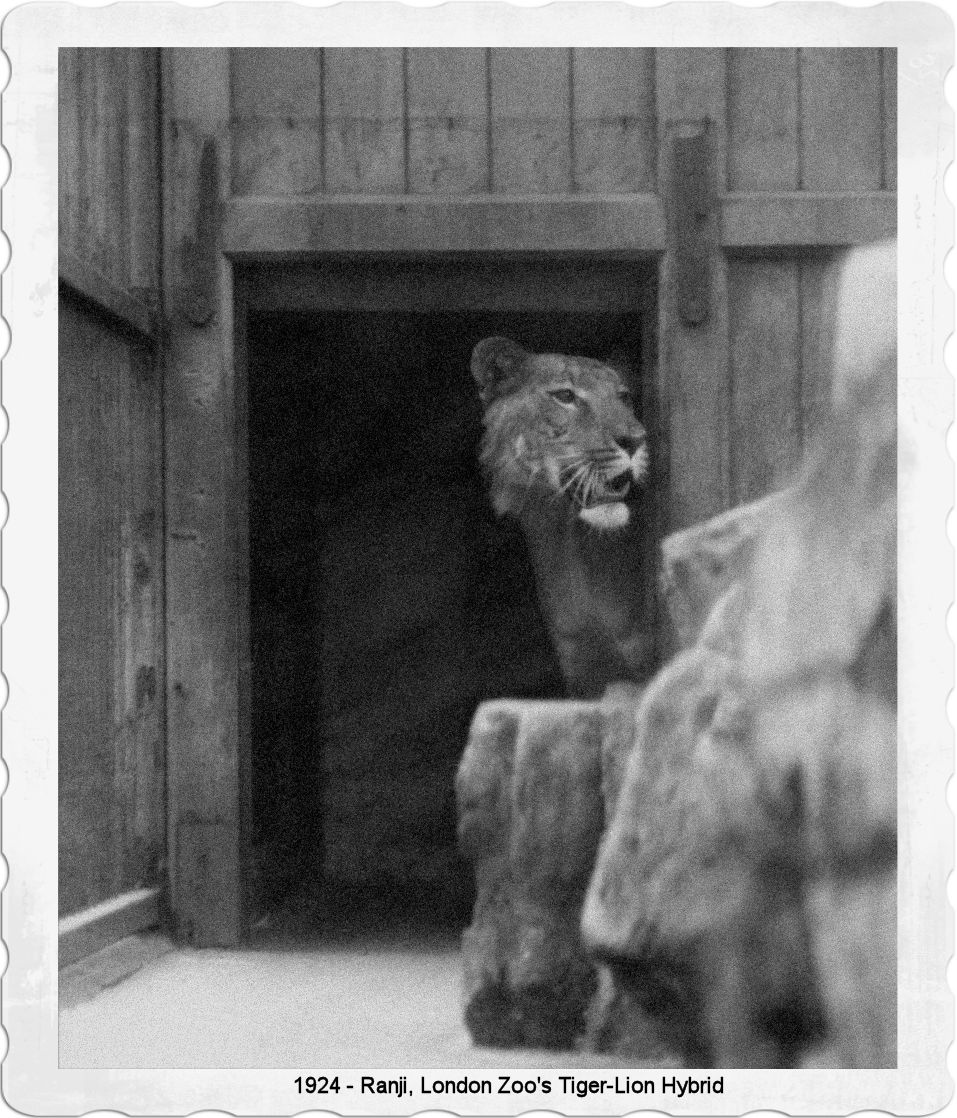
As a rule tigers and lions will not fraternise, and in olden days it was not uncommon for fights to be arranged between them to provide a sensation for the general public or for the guests of some owner of a great menagerie. There are records of this unpleasant form of entertainment running through history from Roman times. Yet there are occasions on which a lion has been attracted to a tigress or a tiger to a lioness, and Karl Hagenbeck, in the story of his experiences published nearly twenty years ago, tells a curious story of trouble between a lion called Leo, that was exhibited in the Old World and the New, and a great Bengal tiger called Castor. The lion, he tells us, was a bachelor, the tiger was mated to a beautiful Bengal tigress and when breeding time arrived the tigress attracted the attention of the lion. The tiger was extremely indignant and very jealous. The lion, conscious of his own strength, would not give way and the tigress was prepared to accept the attentions of one or other. One morning Mr. Hagenbeck, walking through his Zoological Garden, heard a tremendous roaring from the open air cage and found the lion and the tiger engaged in a terrific contest. They were standing on their hind legs and dealing mighty buffets on each other's heads. This was no more than the first stage. They were on the point of rushing into a struggle which would only have ended with the death of one of them, perhaps of both. The keeper intervened and by dint of great energy and courage, succeeded in separating them, but when they were apart, the ground on which they had struggled was covered with tufts of hair and little pools of blood.
At the same time there is inter-breeding between lions and tigers and other of the felidae without any intervention of man. Hagenbeck bred many young from lions and tigers and at one time had at least three of the offspring of a Somali lion and a small tigress. The male hybrid weighed as much as the two parents together, and visitors to his gar dens could not decide whether they were looking at tiger or lion. Hagenbeck found that hybrids were unusually tame and of very mild disposition. They were also unfertile. In another German menagerie there was a union between a lion and a female panther. Unfortunately the panther was not an ideal mother like Saturn, she devoured her offspring. In the Zoological Gardens of Stuttgart certain hybrids were bred by Herr Nill, and among them a cross between the brown and Polar bear, which was sent to our Zoological Gardens. We may be sure then that for the tigon there are no heirs, and there may be no companion so long as he lives. But he will remain an outstanding figure, a little tragic, even pathetic, since the world holds nothing of his kind, and he must follow his restricted way alone.
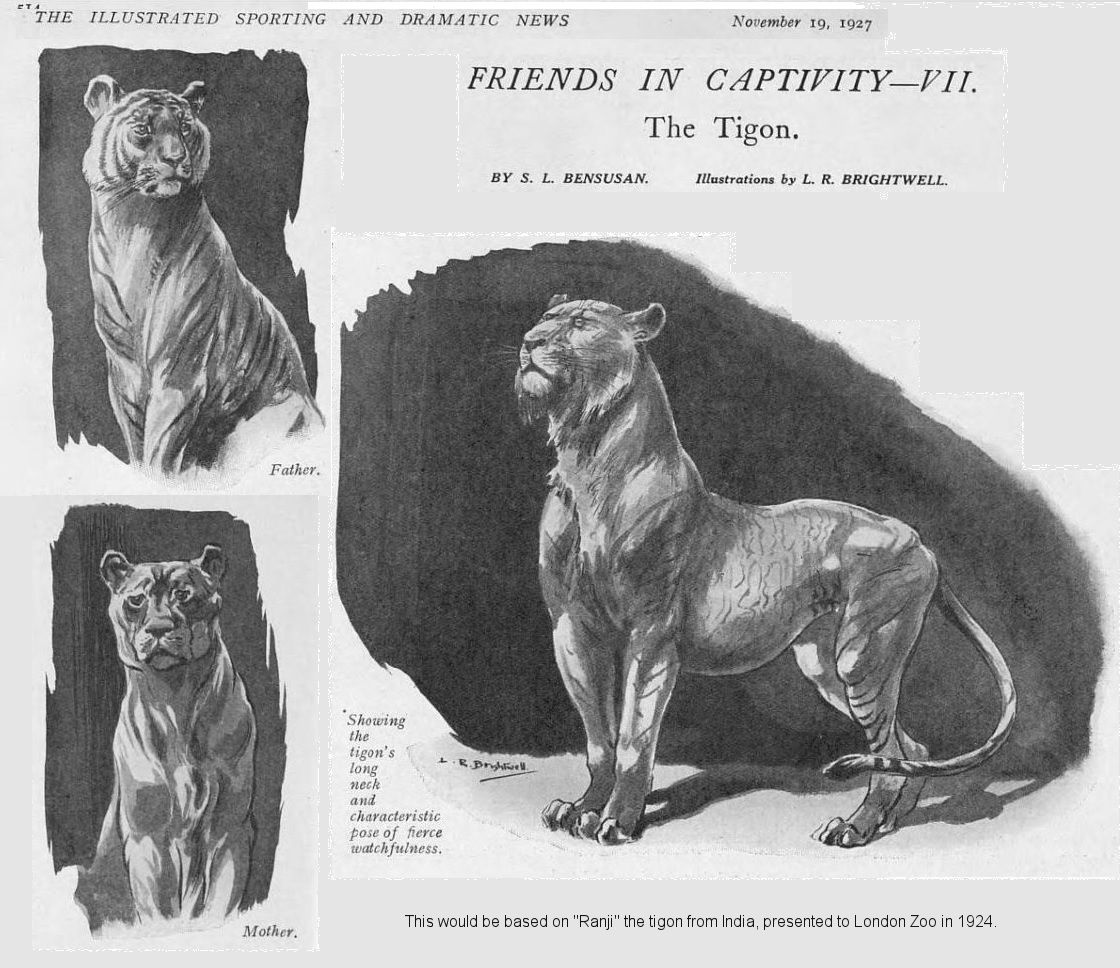
|
|
"At the zoological Gardens in London there has been produced a most interesting hybrid between a tiger and a lion. It has been dubbed the "tigon". It is decidedly not a noble-looking beast, is very long in the leg, where the stripes are most prominent, and of a general sandy hue." The image (from "Wonders of Animal Life" edited by J A Hammerton (1930)) appears to be an edited photograph to give readers the general impression of such a beast (it is probably Ranji).
One observer described the tigon exhibited in London Zoo's lion house as being a striped beast with a ruff round its neck and a surprised expression. |
THE ZOO LOSES ITS "TIGON" - News Chronicle, 7th January, 1932: The Zoo lost yesterday one of its finest and most uncommon animals, the "Tigon" (as the Tiger-Lion Hybrid was called), which was found dead in its cage in the Lion House. "Ranji," who was labelled with that name in recognition of the fact that he was presented to the Zoo by the Jam Sahib of Nawanagar (better known in Britain as Prince Ranjitsinhji, the cricketer), was the offspring of a tiger and lioness who lived in the Prince's private menagerie in India. While the tigon was a cub its father and mother had one fight - and each inflicted fatal injuries on the other. The tigon reached the Zoo in 1924. He was an object of keen interest to all the scientists - zoologists, biologists, doctors and others - who visited the Zoo. Americans were particularly interested in him as a curiosity which was rarely to be found in any zoo. This queer looking beast grew up to be a fine animal, the biggest creature in the Lion House. His fur was short and his skin of the colour of a lion; but his head, with its longer fur, was of the shape of a tiger's, and his purring had the staccato notes of the tiger's purr. "Shadow" stripes also were visible on his skin. Altogether, he was rather more tiger than lion, except in colour. The post-mortem will reveal the cause of his death, which was sudden.
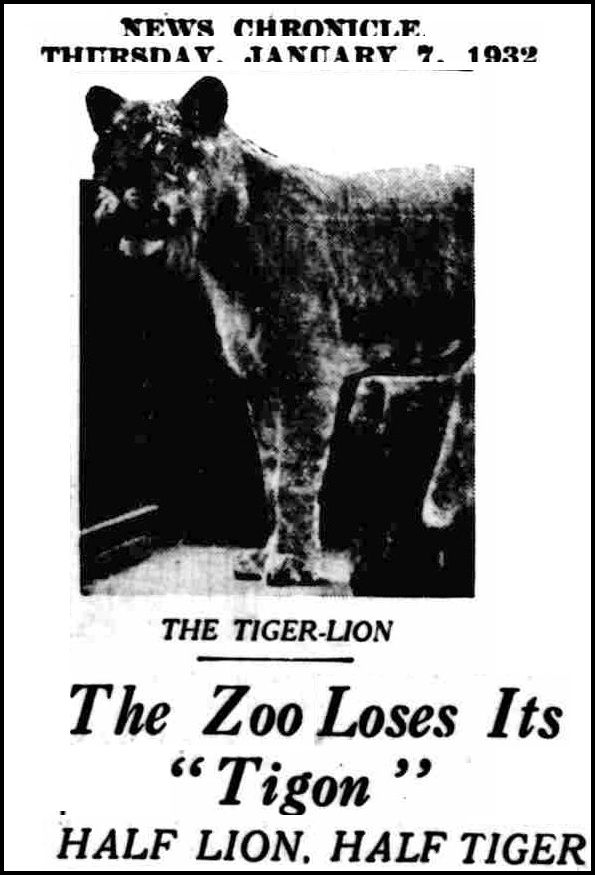
ZOO WANTS A TIGER-LION. EXPERIMENT IN MAN-DIRECTED EVOLUTION. Daily Herald, 18th June, 1936: An attempt is to be made at the Zoo to breed a tiger-lion, or tigon. The animals concerned are a young male tiger, born last year at Whipsnade, and a young lioness, born last June at London Zoo. Only one tiger-lion hybrid has been shown previously at the Zoo. It was bred by the Jam Sahib of Nawanagar in 1921. It lived at the Zoo for about ten years. Professor Julian Huxley, secretary of the Zoological Society of London and advertising editor of the new paper "Zoo," told the "Daily Herald" last night that, in Russia, valuable work in experimental cross-breeding was being done. "I should like to see one day, in the future, and experimental breeding farm attached to Whipsnade,” he said. In a broadcast talk last night, Professor Huzley saif this:- “Perhaps one of the functions of the Zoo ought to be to undertake the experimental breeding of new types – in other words, artificial evolution. Even at its quickest, as in the evolution of new varieties and breeds of domestic animals by man's deliberate selection, it takes many generations to produce and fix a new type."
1930s - THE MANCHESTER TIGONS
According to the Shields Daily News, 31st August 1954, These tigons. First the talk was about tigons (hybrids between tigers and lionesses) and now it swings to ligers (hybrids between lions and tigresses). Our correspondence columns have recently contained two letters on Tigons. They have aroused much interest locally and prompted Mrs N. Monsen, of Sandringham Gardens. North Shields, to write to Belle Vue Zoo, Manchester about the tigon she saw there in 1945. Now the superintendent of the zoo. Mr Gerald T. Iles. has sent her a photograph of the tigon, which we reproduce here, and has given her some information on the liger. He says there are one or two tigons and ligers alive in the world today, including a fine young male tigon in the Vincennes Zoological Park. Paris, and ligers at the Bloemfontein Zoo. South Africa and in Salt Lake City. U.S.A. Maude, the Belle Vue tigon, lived for 13 years until December 1949 at the zoo. Her brother. who was also at Belle Vue. died in 1942. Mr Iles says he always understood that the Belle Vue tigons were bred at the Dresden Zoological Gardens, although he actually purchased them from the famous Hagenbeck's Zoo in Hamburg. Now the Director of the Dresden Zoo has told him that the animals did not come from there, but Mr Iles thinks the director may be wrong, since he did not hold the position at the time the tigons were born. In "At Home In The Zoo" (1961), Gerald Iles wrote "For the record I must say that I have never seen a liger, a hybrid obtained by crossing a lion with a tigress. They seem to be even rarer than tigons." In contrast, Iles was more easily able to acquire tigons for Belle Vue Zoo, Manchester.
BelleVue Zoo was a combination zoo, amusement park and circus, and was also home to a speedway and greyhound racing track. It was once the third largest zoo in Britain, closing in 1977. Gerald Iles became its director at age 21, very young until you realise that his uncle owned the park. He was one of the first zoo directors to have a university degree in zoology. He received a letter from the Maharaja of Rewa offering the white tiger that was for sale in I guess 1951. He was recruited by the city of Montreal to be the director of a proposed "super zoo" that was never built. He remained in Montreal, aged 46 and unemployed and oddly - did not become director of any North American zoos. He became the head of the Monarchist League in Montreal. Gerald Iles said that the director of Dresden Zoo told him that the tigons weren't born at Dresden Zoo back in 1932, but that Gerald Iles thought this was wrong. There doesn't seem to be any record of Dresden Zoo having exhibited a tigon. Gerald Iles apparently used to stay with the Hagenbeck family (as did Herman Goering!) . Iles seemed to like Germany enough that wanted to become a permanent resident. The only source claiming the tigons were from Dresden Zoo was Iles himself. Is it possible that Hagenbeck, the animal dealer, mistook where the tigons came from when selling them?
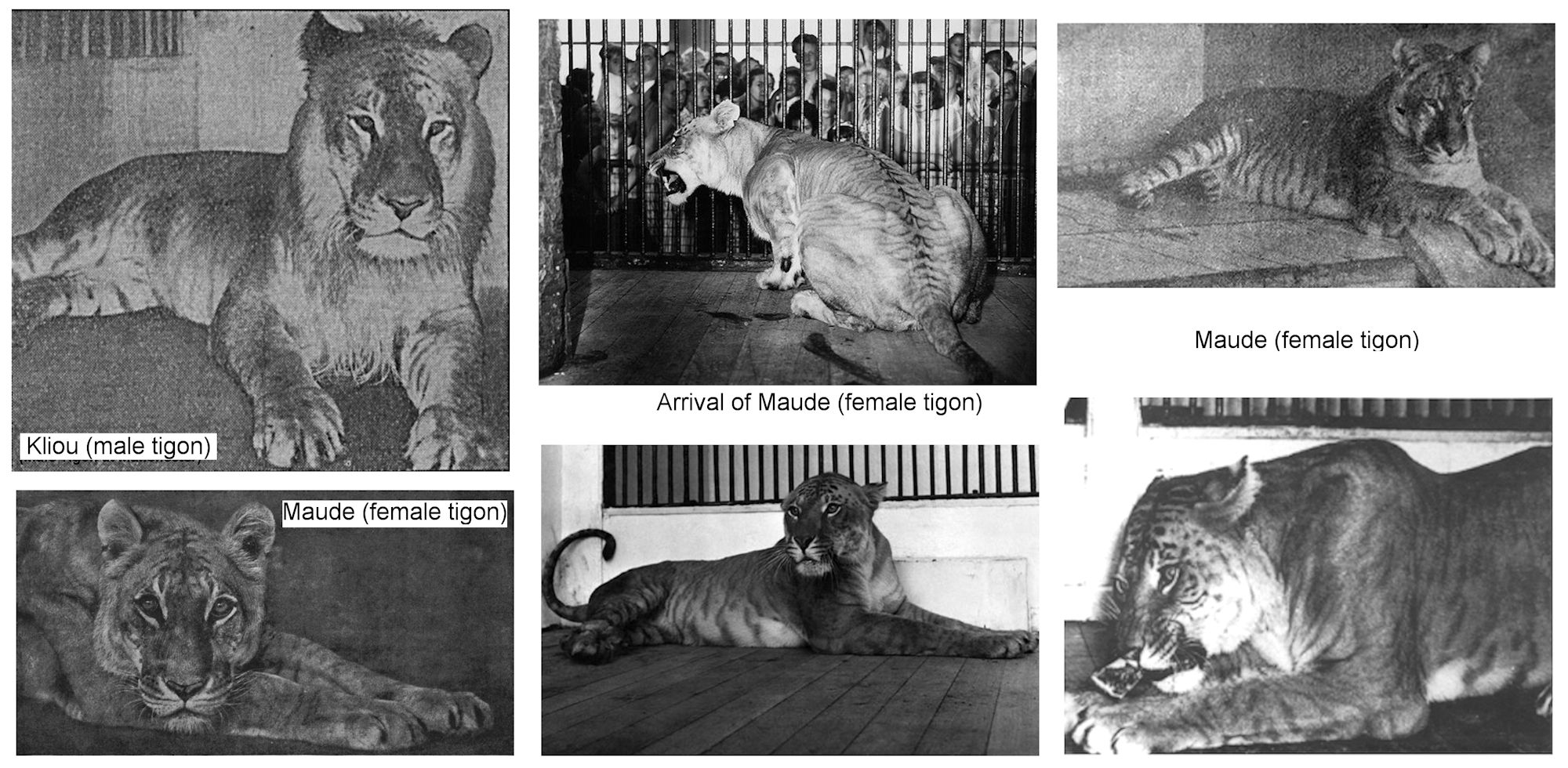
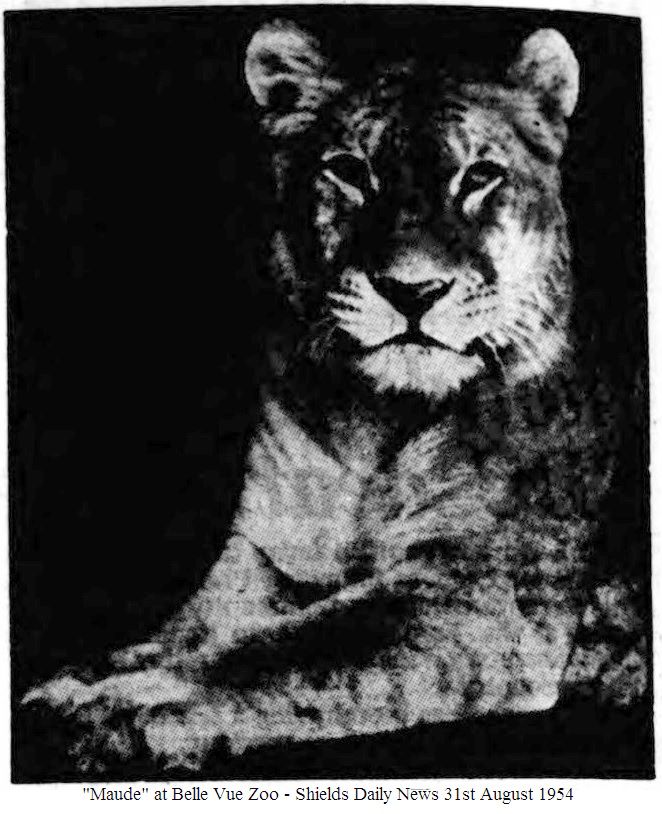
Belle Vue Zoo in Manchester, England had a succession of tigons between 1936 and 1968. Kliou (male) and Maude (female) were born at Dresden Zoo, Germany in 1932 and were bred from a Manchurian tiger x African lioness mating. They were acquired by the Hagenbecks at an early age. Gerald Iles of Belle Vue Zoo obtained them from Heinrich Hagenbeck at Hamburg Zoo in 1936. Gerald Iles, who obtained them for Belle Vue Zoo wrote in "At Home In The Zoo" (1961): "The male was a large animal with a mane - not so much as a lion but more than the ruff of a tiger. His general colour was a pale fawn with light brown shadow stripes on the head and body. The under parts were almost white, as in the tiger, and the ears bore the marking of the tiger and the colour of the lion. The female was similar except taat she lacked the mane. She was larger than the usual tigress or lioness. Both roared like lions. The price for the pair was 325 which I though comparitively cheap for such rarities, even in those days."
KLIOU AND MAUD. Daily Dispatch, Jan 28th 1939: THE first attempt to solve the problem of overcrowding in the house centred on Kliou and Maud, the tigons, who once lived so happily together, but to-day are deadly enemies. After a separation of several months, thought the keepers, the hearts of these erstwhile cage-mates might have softened. They were wrong. How wrong they discovered about ten seconds after they had opened the door between the cages. Kliou bounded through the door and stood stock-still as his eyes lighted on his former mate. Then two sets of teeth were bared and the fight began. Kliou, as the aggressor, chased Maud all over the cage, clawing at her and biting, she did not let him have it all his own way, and got in one or two well-aimed blows as she sped across the cage. The climax came when she retreated on to the flat top of the sleeping den at the back of the cage. Kliou followed her and they were quickly locked in fierce struggle, each reared on hind, legs. They lost their balance and came crashing down on the cage floor six feet below. Maud was underneath, bleeding profusely from a wound on her paw, and it seemed she must be badly injured. Keepers with long bars and loud voices managed to drive her assailant back into his own cage, and were relieved to see that Maud was not badly hurt.
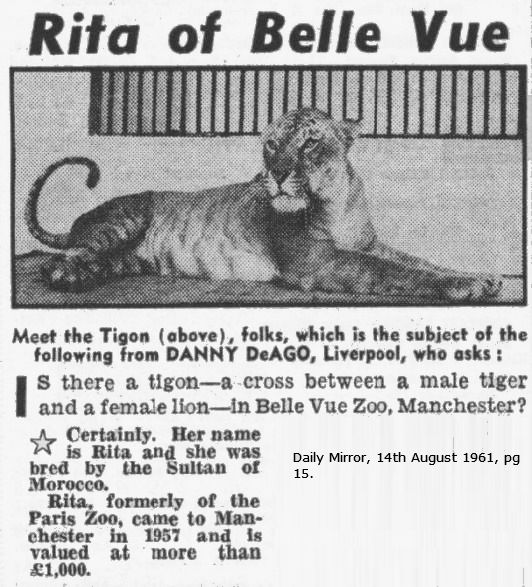
Kliou, like all F1 males, was sterile, but this did not prevent him from trying to mate with Maude (who was probably fertile and was evidently coming into oestrus). The fact that Maude did not conceive meant she would have been in oestrus unusually often and Kliou's attempts appear to have become a nuisance to her. To begin with, Kliou and Maude shared an enclosure and mated frequently, but they later fought when Maude repelled Kliou's attempts to mate and had to be housed separately. Kliou made repeated attempts to get into Maude's cage. Kliou died of tuberculosis in March 1942 and Maude became even more serene and regal. She died aged 18 of gastro-enteritis in December 1949 after catching a chill when the lion house heating failed. In 1957, Belle Vue zoo obtained another tigon called Rita. Rita came from Paris Zoo who had obtained her from the Sultan of Morocco. She was smaller than either Kliou or Maude, perhaps coming from different subspecies of lion and tiger, and lived until February 23rd, 1968. She spent 12 of her 20 years at the zoo and was the only tigon in Britain. (Star Tribune, Minneapolis, 25th Feb 1968, pg 2). According to the Dayton Daily News (Ohio), 23rd February 1968, pg 46: The Bellevue zoo s Tigon . . . has been found dead in her cage, zoo officials said. The tigon, Rita, was given to the zoo 12 years ago by the Sultan of Morocco. Among the rarest of animals, it was worth about $12,000. A zoo spokesman said Rita apparently died in her sleep.
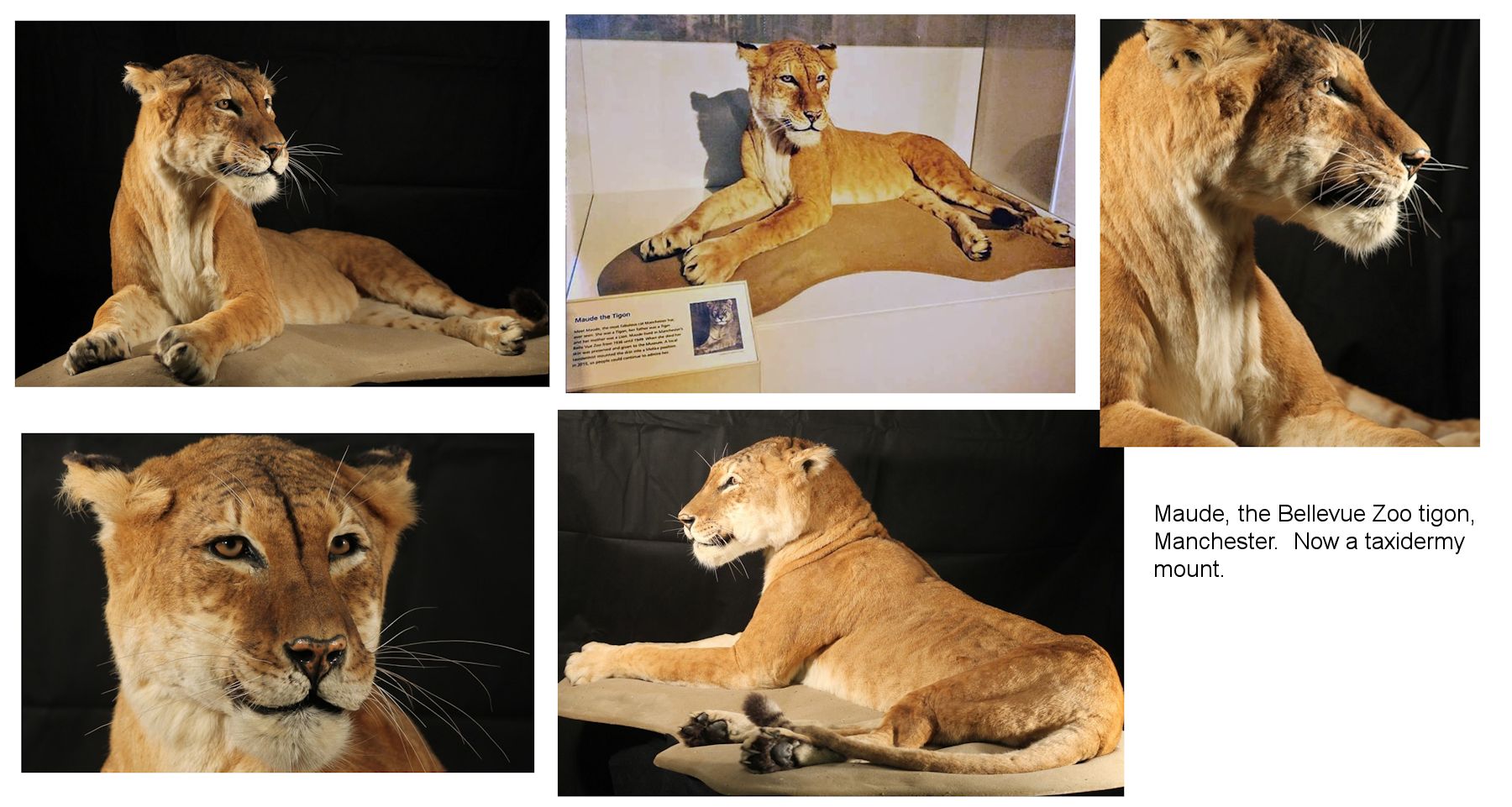
1960s - JUNGLE LARRY'S "TIGLONS"
Jungle Larry Tetzlaff had animal exhibits at Cedar Point, Sandusky Ohio area in the 1950s early 1960s before opening his operation to Caribbean Gardens in Naples, Florida in 1969. In the late 1960s, Larry noticed Princess the lioness and Rajah the tiger (an orange tiger carrying the white gene) were interested in each other. At that time, animals were not kept genetically pure for conservation so he allowed them to meet and they mated. On September 21, 1969, at Cedar Point, Princess produced three "tiglons;" Sultan and Rajah (males) and Maharani (female, apparently born paler than her brothers). The triplets became famous on regional and national media. As they matured, Sultan and Rajah needed to be separated from each other. Maharani preferred Rajah and these two lived out their lives together. Maharani reached the age of 18, while Rajah and Sultan exceeded 21 years. The triplets passed away in the Naples gardens in the 1980s and 90s. (In 1980, Tetzlaff bred a lepjag hybrid.)
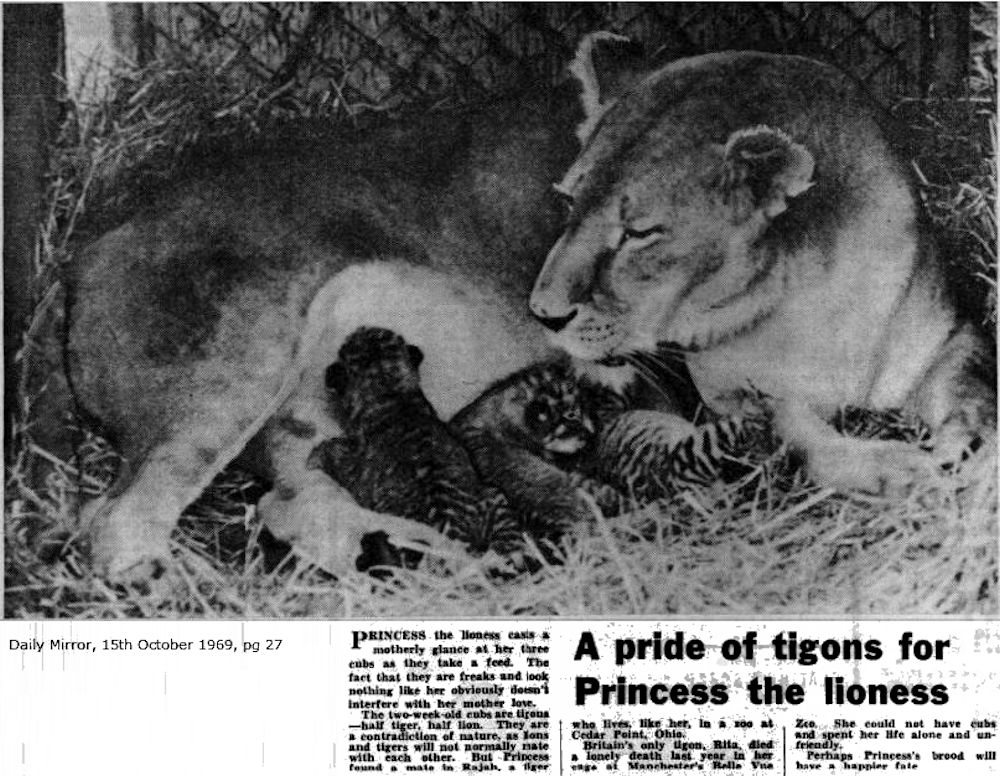
More details of the Tiglons were published in the El Paso Times, 25th January 1970, pg 4: TRIPLET TIGLONS IN NAPLES, FLA., BELIEVED ONLY ONES IN THE WORLD. The lion s natural home is Africa and the Gir Forest of western India, that of the tigers, Asia. Tiglons, however, have adopted the warm and sunny clime of southern Florida as their place to roam. On occasion when lions and tigers have met they have proven to be natural and vicious enemies. Larry Tetziaff, better known as TV s Jungle Larry, partially disproved this age old antagonism by bringing the two together.
Princess, an African lioness, and Rajah, a Royal Bengal tiger, first met at Cedar Point, Ohio, in May of this year. But, like so many northerners, they now make their home in Florida at Jungle Larry s Safari Land at Naple s Caribbean Gardens. The proud parents are rearing triplet tiglons, a rare breed of wild animals in the near natural habitat of their homelands. About mid-May of this year [1969] Tetzlaff started putting Princess and Rajah together in the same cage and found them to be compatible. Previously Rajah had been an excellent breeder and Princess had reared two lion litters, so Tetzlaff decided to cross-breed and create a tiglon.
The cats were started out for a period of ten minutes a day together, without Tetzlaff in the arena. The time period was extended until they were living together completely without supervision. As a result, an actual mating took place on the 24th of May. These rare tiglons, about two months old now, have the stripes of a tiger, the orange-beige color of their other and the temperament of both.
A few tiglons have existed in Europe over the years but as far as Tetzlaff knows, only two litters have been born in the United States during the last hundred years. Several years ago, a lioness belonging to Evelyn Curie, noted big cat trainer and descendant of Madame Curie. Had a litter of tiglons but none of these are living today. Tetzlaff s triplet tiglons are, therefore, believed to be the only ones in the world today. He considers them priceless.
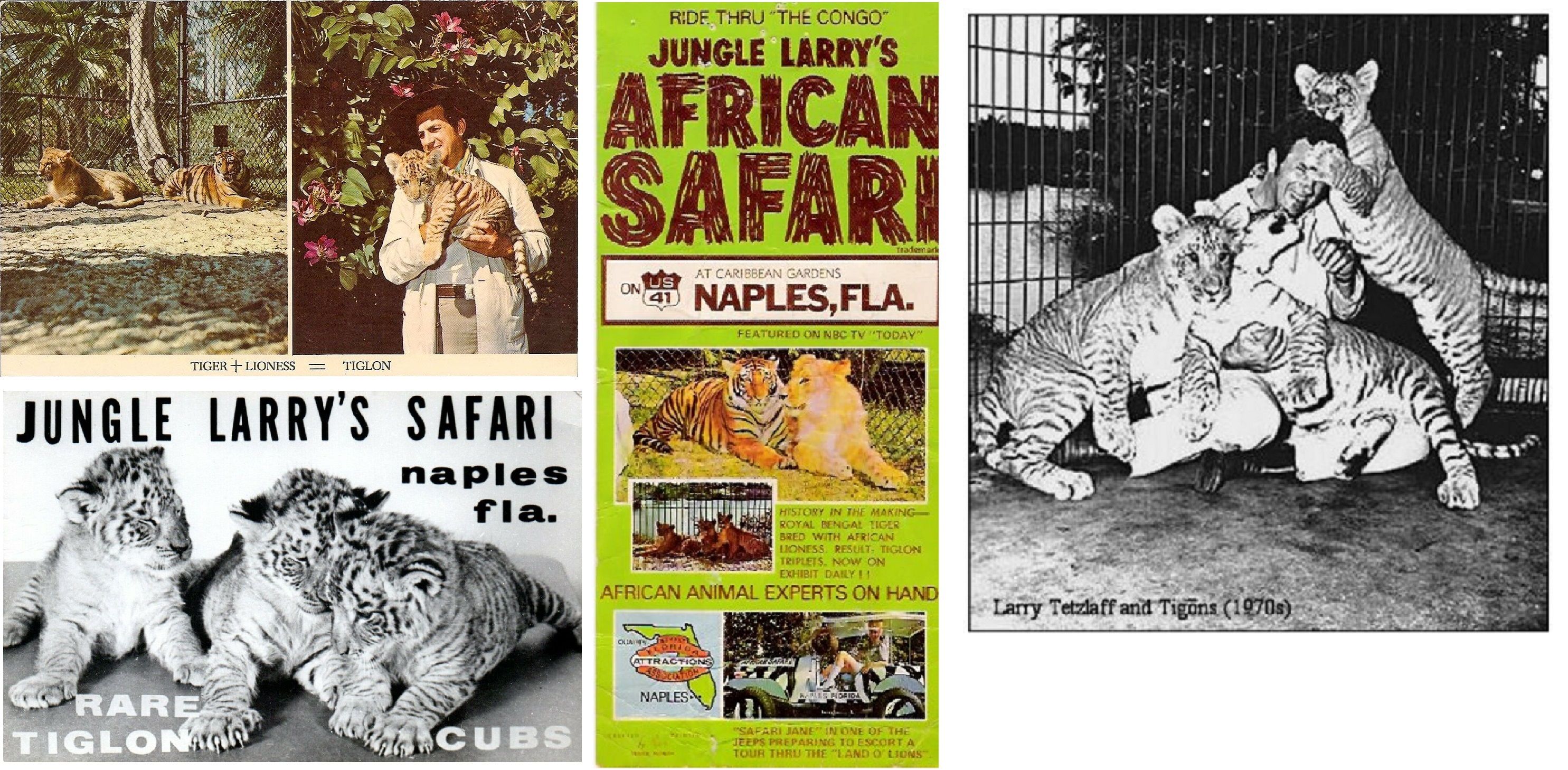
A more detailed description of how the lioness and tiger were persuaded to mate was published in The Evening Herald of Shenandoah, 22nd July, 1971 pg 20: TIGLON TRIPLETS NOW ZOO CELEBRITIES. NAPLES, Fla Less than two years ago a blessed event occurred that delighted zoologists all over the world. Lawrence (Jungle Larry) Tetzlaff had succeeded in mating a giant Bengal tiger and a large African lioness. This resulted in the birth of not one, but three offspring, which are called tiglons.
During the early part of 1968, Tetzlaff, internationally known zoologist and entertainer, noticed a slight interest between Rajah, the tiger, and Princess, the lioness. Since they are natural enemies, this intrigued the trainers and keepers at Jungle Larry s Safari Land in Naples. It was decided to attempt a cross-breeding. When the two were left alone in the big exercise area, however, they began fighting. Nothing very serious, but not compatible to mating. The animals were separated, and a communication program was started.
IF A LIONESS desires to mate, she makes a rather soft sound like Ooooommm. She never roars at her mate almost never, that is. When a tiger wants a friendly wife, he goes Pffffffftttt! One hostile action by either would end the romance. When any such unsocial sound was made, the keepers would refute it with a friendly identification sound and fool the cats. It proved to be a very satisfactory plan. Jungle Larry and his trainers started placing the big cats together during seasonal periods for only a few minutes at a time. This was gradually increased until the cats accepted each other. After a year of patient cupid-playing, a happy wedding took place and Princess gave birth to tiglon triplets. Two males were born first and then the female. They had the color of lions but the stripes of tigers. The cubs have adopted the warm, sunny clime of southern Florida as their place to roam.
THE BIRTH of tiglons could not have happened in Africa because there aren't any tigers there. It could have taken place in the Gir Forest in West India, where the almost extinct tiger is still found. However, a natural, wild state breeding has never been recorded.
Tetzlaff and his trainers believe that as a result of cross-breeding, the cats are extremely intelligent and very receptive learning new tricks. Jungle Larry says: The tiglons reflect more love than any of the big cats I have trained over a period of 30 years, including jaguars, leopards, lions and tigers. The triplets have been trained and perform daily at Jungle Larry's Safari. They have made several television appearances, including one on the Today Show. Jungle Larry is in the process of teaching a male African lion and a Royal Bengal tigress to cross-breed. He says: If any offspring come out of this union, they will be ligers. Of course!
The Tampa Tribune, 15th November 1970, pg 4-B: ONLY 3 SURVIVING TIGLONS SURVIVING IN NAPLES GARDENS. Maharaja, Maharani and Sultan, the only three tiglons in the world, are now more than a year old and are big, healthy and energetic. The three animals, whose father was a tiger and whose mother was a lioness, were born Sept. 21, 1969 in the Jungle Larry Safari tourist attraction in Naples. The attraction is also known as Caribbean Gardens.
THE TIGLONS, two males and a female, look like lions with light stripes. They now weigh over 200 pounds each, eat five to 10 pounds of food a day and put on two shows a day with either Jungle Larry Tetzlaff or Milt Wagner. Wagner said the female has the fiery, unsociable personality of a tiger, while one of the males acts as lazy and sociable as the typical lion. The other male, he said, can t seem to decide what he is and acts like a tiger part of the time and like a lion the rest of the time.
A FEW WEEKS after the tiglons were born they. were shown on national television and were the subject of many articles. Since then they have grown up well without suffering any serious illnesses or having any other serious problems, Wagner said. The Tiglons are the result of the mating of a 650 pound Bengal tiger and a 450 pound lioness, animals which are usually natural enemies. To overcome the hostility between the two animals they were placed in cages beside each other for about six months to get used to each other before they were put in the same cage. Eventually, Wagner said, they plan to breed the tiglons. But it will be two more years before they are old enough to conceive, he said.
AS FAR as they know, Wagner Said, a tiger has been mated with a lioness only one other time [in the USA]. But no records were kept and those tiglons are now dead, he said. In contrast, complete records have been kept of the tiger-lioness mating, the birth and the raising of the these tiglons, he said.
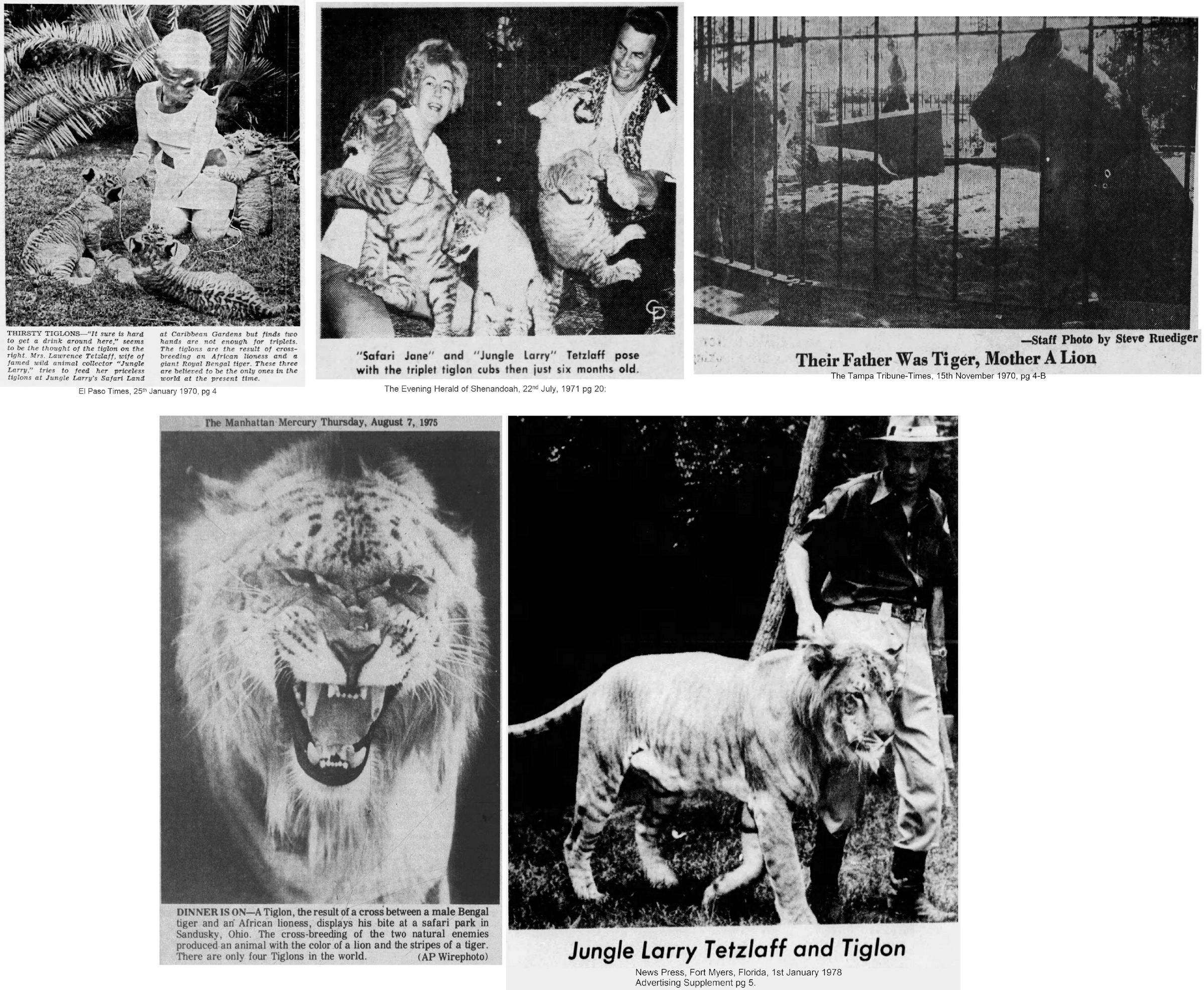
The tiglons were a great attraction, but one tiglon injured a small child who managed to get too close. According to the Tampa Tribune, 11th January 1971, pg 2-B, YOUTH INJURED WHILE FEEDING SAFARI2 TIGLON. Naples. A 7-year-old New Jersey boy who tried to feed animal crackers to a 190-pound tiglon, a cross between a lion and tiger, was clawed severely on his face late Friday at Jungle Larry s Safari at Caribbean Gardens here. John James Wilkie, Camden, N.J., was last reported in good condition at Naples Community Hospital. He underwent surgery for three hours at which time a countless number of stitches were needed to close the face wounds.
With his vacationing parents, Mr. and Mrs. William Wilkie and three other children, the boy was touring Jungle Larry s and had just seen the 4 p.m. animal show. The boy apparently got past the wire barrier several feet away from the cage and walked to the bars to throw an animal cracker to one of the three tiglons.
John had heard one of the trainers threatening not to feed the tiglons because they wouldn t perform all of the tricks, the boy s father said. I guess he trainer was just joking but my son loves animals, and he apparently took it to heart and he wanted to. feed the tiglon.
Lawrence E. Tetslaff, owner of Jungle Larry's said this was the first time anything like this had happened in his 35-year-career.
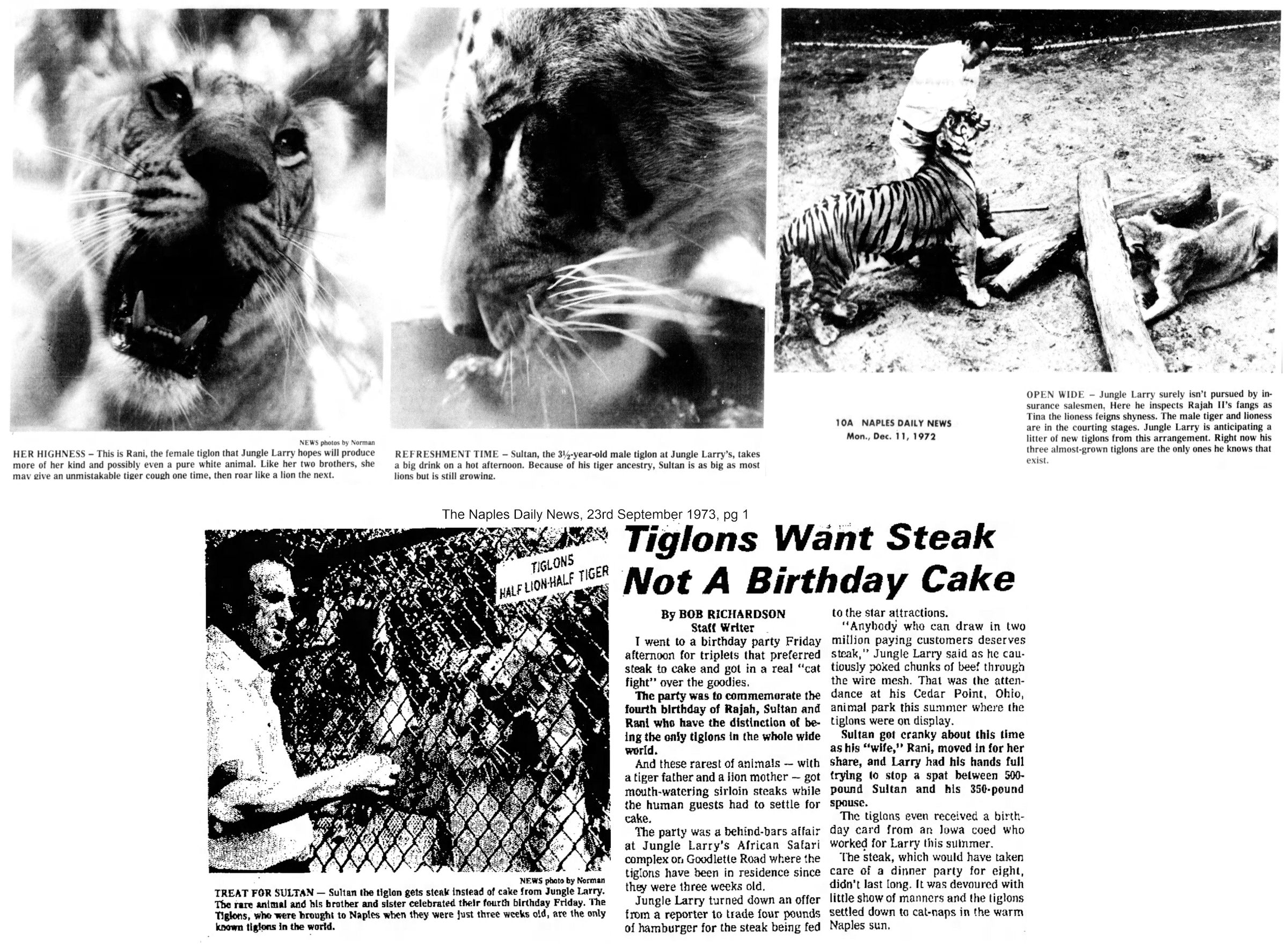
The Naples Daily News, 11th December 1972, pg 10A: HOPE FOR MORE TIGLONS. TIGER AND LION ARE WED AT JUNGLE LARRY S. An unusual couple has taken up housekeeping in Naples. He s a big, gruff fellow who favors fancy dress and you probably wouldn't want him to invite you for dinner. The lady's demureness shouldn't be confused with her great courage or sometimes snappy disposition. And the couple is making history of sorts in Naples because this is the first marriage of a male tiger and female lion here in an effort to produce more tiglons for Jungle Larry's African Safari at Caribbean Gardens.
Tiglons, to the few in this area who don't know, are as rare as a benign tax collector. The only three known to exist are Sultan, Rajah and Rani who have resided at Jungle Larry's since they were 21 days old. Now 3-and-a-half, the Naples tiglons were neither conceived here nor born here so if the new tiger-lion couple, Rajah II and Tina, plan to have a family their tiglon cubs will be a Naples first.
We're the only zoological garden that has a breeding program to produce tiglons, Jungle Larry said. Quite a few years ago Evelyn Curie - she was the great granddaughter of the famed Madame Curie - unveiled a tiglon when she was a trainer for the Ringling Brothers circus. But she never had it bred."
How can a male tiger and female lion be compatible? It's a carefully planned training and conditioning program that prevents [permits] this plus 10 years of secrets I've gained through experience, Jungle Larry said.
Lions and tigers live continents apart in their wild states (it's conceivable that the rare Indian lion in the Gir Forest might range in tiger area) as there are no tigers in Africa.
What we do first we started with Rajah and Tina in October - is to put them in adjoining cages separated by a steel wall in which we drill several holes, the jungle expert said. That way they can see each other eyeball to eyeball and catch each other s scent. They are watered and fed in a common pen which also helps condition them. But they still can't get at each other until we sense they re psychologically ready to be friends, he said.
Experience tells Jungle Larry when the tiger and lion can be released together in a large compound at the Caribbean Gardens. There they can be seen daily - nuzzling at times and many times ignoring each other. Any time now, Jungle Larry says, they could decide they want a family. Later, after a gestation period that could last from 108 to 123 days, the couple could expect as many as six tiglons that will look more like lions with faint stripes, yet act like a tiger one day and lion the next.
Jungle Larry says he is not producing tiglons merely for publicity. Sure, he said, lots of people come here especially to see our tiglons. But, to me, it is a scientific project because of the genetic possibilities. His tiglons have a white gene that may produce a pure white animal some time in the future. There is a remote possibility that our breeding program gives us a prehistoric throwback possibly something closely resembling a sabre-tooth tiger, he said.
And he has planned his program of breeding jaguars, leopards, lions, tigers and tiglons to someday produce a super cat. We'd get this super cat by breeding tiglons to leopards or jaquars and these offspring with each other. I can foresee a huge animal with the tiger s bulk, the jaguar s great strength, the leopard s speed and cunning and the lion s beautiful great mane, he said.
Jungle Larry might very well produce Tiguars, leolions, Jagards and ligers. Only a scientist. could conjure up a name for a combination of these animals.
It's all in the diet, Jungle Larry says. When zoos used to feed big cats only raw horsemeat they had poor breeding success. We spend over $300,000 a year on a special diet for our cats. It s ground up horsemeat and bones mixed with rabbit, chicken and special vitamins. The vitamins cost as much as the meat.
So it s belated best wishes to Tina and congratulations to 600-pound Rajah II who are now at home to visitors at Jungle Larry's African Safari at Caribbean Gardens.
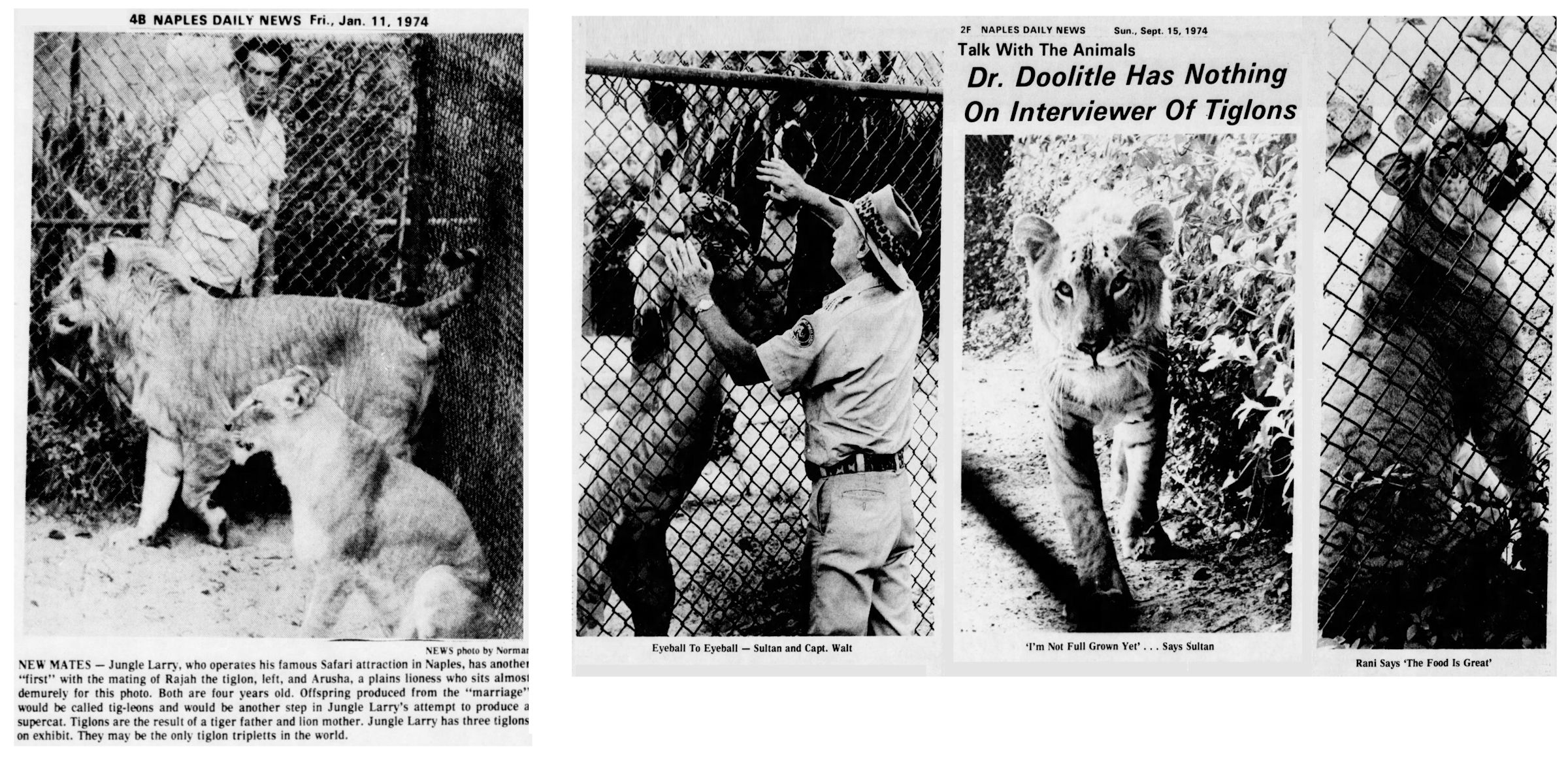
According to the Naples Daily New, 11th January 1974, Jungle Larry tried to breed a 2nd generation hybrid. NEW MATES. Jungle Larry, who operates his famous Safari attraction in Naples, has another first with the mating of Rajah the tiglon and Arusha, a plains lioness . . . both are four years old. Offspring produced from the marriage would be called tig-leons and would be another step in Jungle Larry s attempt to produce a supercat. Tiglons are the result of a tiger father and lion mother. Jungle Larry has three tiglons on exhibit. It is a surprise that Jungle Larry seemed unaware that male hybrids were sterile in spite of showing sexual behaviour. He could have made progress by crossing his female tiglon to a male lion.
Naples Daily New, 15th September 1974, pg 2F. TALK WITH THE ANIMALS. DR. DOOLITLE HAS NOTHING ON INTERVIEWER OF TIGLONS. By Don Good, Staff Writer.
So, with the help of the good folks at Jungle Larry s African Safari in Naples, this writer set out to interview the offspring of a Bengal tiger and an African Bush Lioness, Rani [Maharani] and Sultan, the tiglons, currently in residence at Jungle Larry s. The tiglons greeted their interviewer with a roar that could be heard across the compound of the wild animal habitat off Goodlette Road. The introduction was made by Captain Walt of the Jungle Larry staff.
The first question posed was, Say there, young man and young lady, how old are you? The reply was, We will be five years old on September 21st. Our brother, Rajah, is currently at the Jungle Larry location in Sandusky, Ohio. Incidentally, we were born in Sandusky .
When will you reach your full maturity? was the next question. At about our sixth year. Right now, we weigh in the neighborhood of 400-500 pounds, and in the next year we will probably top 500 pounds as we reach full growth .
Our attention was called to the size of the pads on their feet ... at least 9 to 10 inches across their broadest point. Another indication of their size was presented by Sultan as he rose on his hind legs, resting his front paws against the heavy wire cage . . . What an animal! He was literally something to look up to!
Now look, you two, tell me about your eating habits, will ya ... what do you eat and how often? , this writer asked. Our diet consists of nothing but meat. A special formula of chicken, horsemeat and beef, especially prepared in eight pound blocks, is shipped here from a Kansas supplier. We are fed once a day in our night house, and we eat about 10-12 pounds of this concoction each day. It s great stuff! Very filling, and increases our roaring ability. The two animals agree the food is unbeatable.
The two added that they are fed in the evening, with the food being placed in their night house, an especially constructed shelter for the animals conforming to federal laws regarding wild animals in captivity. The food is placed in these houses, and the animals know each evening they must go to the night house to eat. The night houses are scrubbed down each day by attendants and they re spotless , the two beautiful animals agree.
Capt. Walt, who accompanied this newsman to the cage of the tiglons and assisted in the interview , called our attention to the markings of the animals, characteristic of their parents. They both showed the stripes of the tiger, and the mane of the lion was very much evident on Sultan. As we were about to leave, Capt. Walt allowed the two cats to lick his hand as he held it up to the cage. He bent over as if to kiss the two goodbye, and he was observed in an eyeball to eyeball confrontation. This author was somewhat glad that he wasn t invited to participate in a goodbye ceremony with the two cats . . . but on the other hand . . .
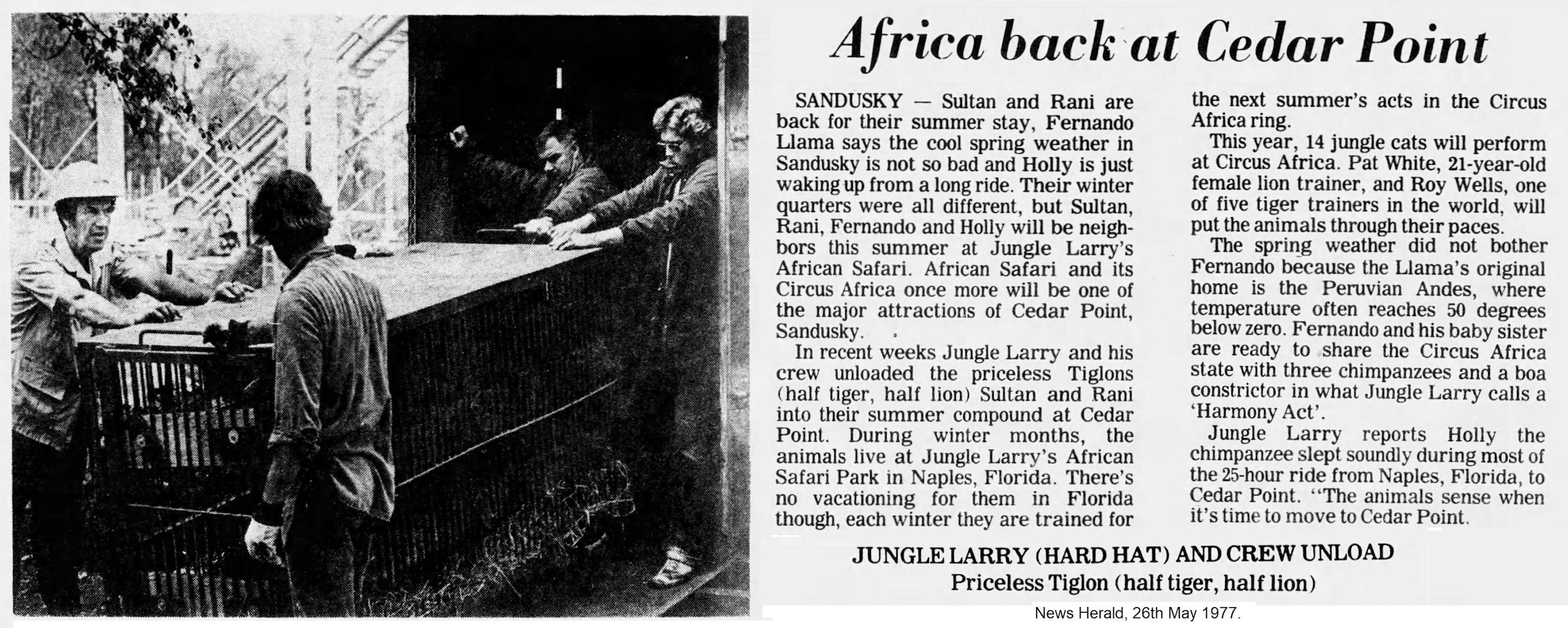
IN The Lima News, 1st June 1977, pg B5, Jungle Larry again described the creation of his tiglons and his aspirations to breed the male and female tiglon together, to breed the other male to a lioness and to breed one of the hybrids to a jaguar. Jungle Larry had been told that even if he could coerce his tiger and lioness to breed, the odds against a litter being produced could be as high as a million to one. So why try? . . . to breed lions with tigers has been a life Jong ambition for Jungle Larry, who runs safaris at Cedar Point amusement park in Sandusky and in Naples, Fla. . . . In the spring of 1969. he had the male tiger and lioness living together at Cedar Point. This in itself was a major accomplishment because the two are natural strangers, he said. Jungle Larry said the only way such animals can overcome their natural animosity is by their faith in their trainer.
He and his assistant trainers spent hours talking to the animals, reassuring them they can get along with each other, telling them that all is well. Despite the cozy living conditions between the tiger and lioness, their relationship had not been consummated. Deception then proved the best matchmaker. On May 21, 1969, Larry and one of his assistants hid from view of both animals. One of them blew through his lips, and said, Frumph! Frumph! imitating the mating call of the tiger. At the same time, the other hummed, Umh, Umh, the lion's mating call. On Sept. 21, 1969, the lioness gave birth to two male tiglons and a female tiglon. One male and the female are featured in the Cedar Point Safari. Jungle Larry hopes to breed them to continue the family. Meanwhile, he intends to breed the other male tiglon at Naples with a lioness. With their offspring he intends to breed a jaguar. Jungle Larry said he owns three of the only four tiglons in the world. He said a tiglon is characterized by the abbreviated mane of a lion, spots on his head and stripes found on a tiger and an orange color.
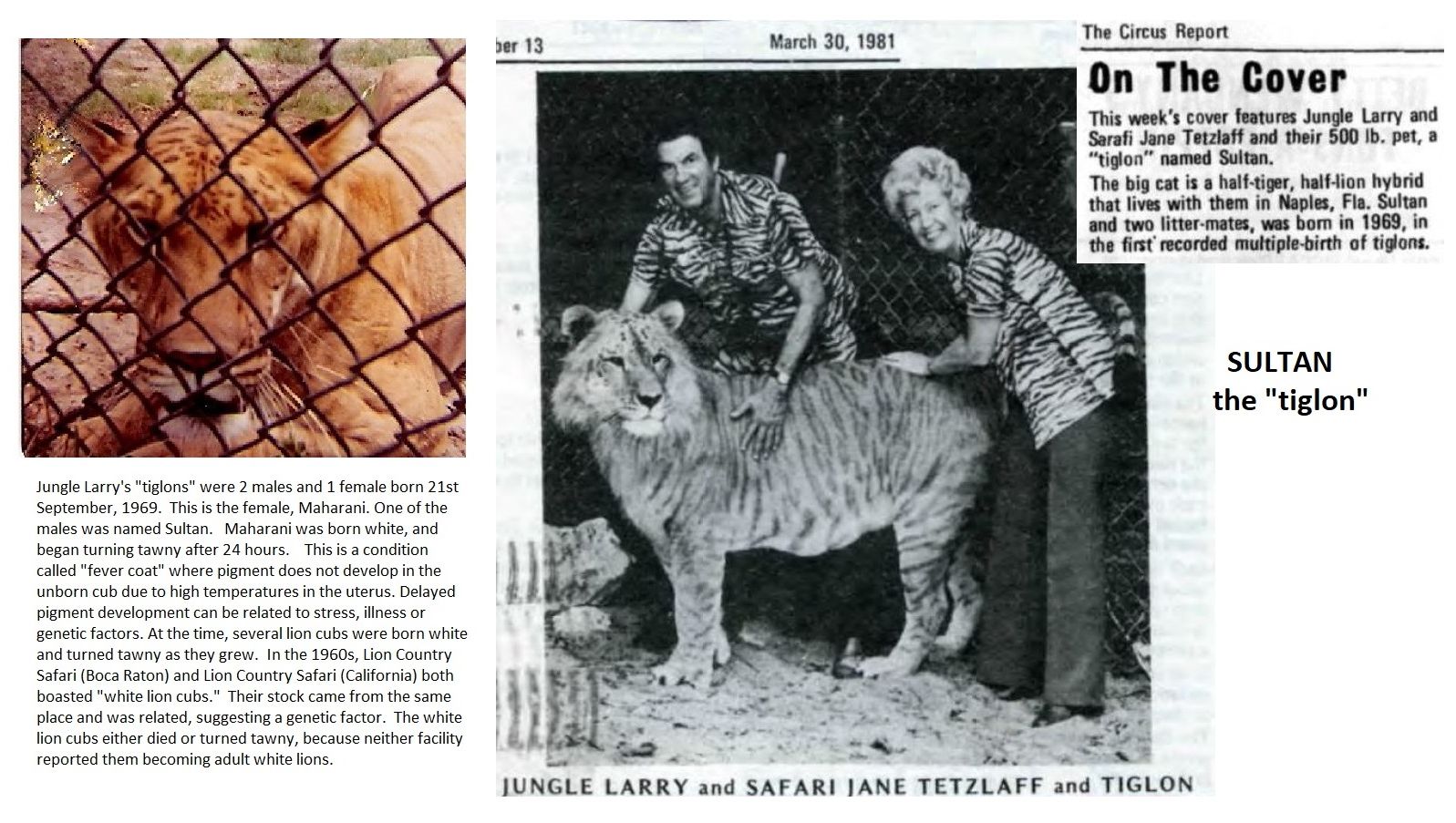
Animal trainer Evelyn Currie, one of the first female lion and tiger tamers for Ringling Brothers Circuses, had a a tiglon that she boasted (incorrectly) was the only one in captivity in the world.. Roberto, Evelyn Currie's tigon, was born on 1st October 1958 and had two littermates named Maria, and Volney. Their mother was a lioness named Tillie.
THREE TAWNY TIGONS TRAINED TO TRAVEL, Plainfield Courier-News, Plainfield, New Jersey, 1st November 1958 pg 11. Gillette Volney Phifer s Animal Farm in Old Morristown Rd. has done it again and this time it is in the middle of a muddle about a trio of tawny Tigons. . . . According to Phifer they re a combination of the animal kingdom s most feared citizens a lion and a tiger. Right now they resemble neither. The three tawny cubs were the result of cross-breeding a tiger and a lioness by Mrs. Evelyn Currie, a professional animal trainer. They were born on Oct. 16 on the road with the Pollack-Shrine Circus, arriving here a few days later.
We believe they re the only tigons in the United States, said Phifer, who recalled a similar breeding in Central Park Zoo, New York City, five years ago produced a single offspring. The New York Tigon died before reaching maturity, according to Phifer. They ve been pretty popular with visitors to the farm, Phifer remarked . . . Phifer said the three Tigons bear a tawny color similar to a lion and are spotted to their hindquarters. Their tails are striped. The two males and one female will be incapable of reproduction because of their high degree of breeding, according to Phifer. The Tigons named Roberto, Maria and Volney (for Phifer) depart the farm Monday for an eastern swing with the Pollack-Shrine Circus.
CIRCUS ANIMALS ARRIVE SAFELY FOR TOPEKA SHOW. The Kansas City Times, 24th February 1960, pg 16. A truck load of five lions, three tigons and a tiger arrived here shortly after 6 o clock tonight after a perilous trip over snow-covered roads from Kansas City and settled in the warm basement of the Topeka municipal auditorium . . . When the lions, tiger and tigons arrived, it was decided not to attempt to unload them at the fairgrounds and they were taken to the municipal auditorium.
Roberto, aged a year and a half old, escaped from his cage in March 1960 while being photographed. The animals were unsettled after leaving Kansas City on Sunday 6th March and travelling to Wichita through heavy snow. Photographers were waiting at Wichita to photograph the rare tigon. This incident was reported in many newspapers.
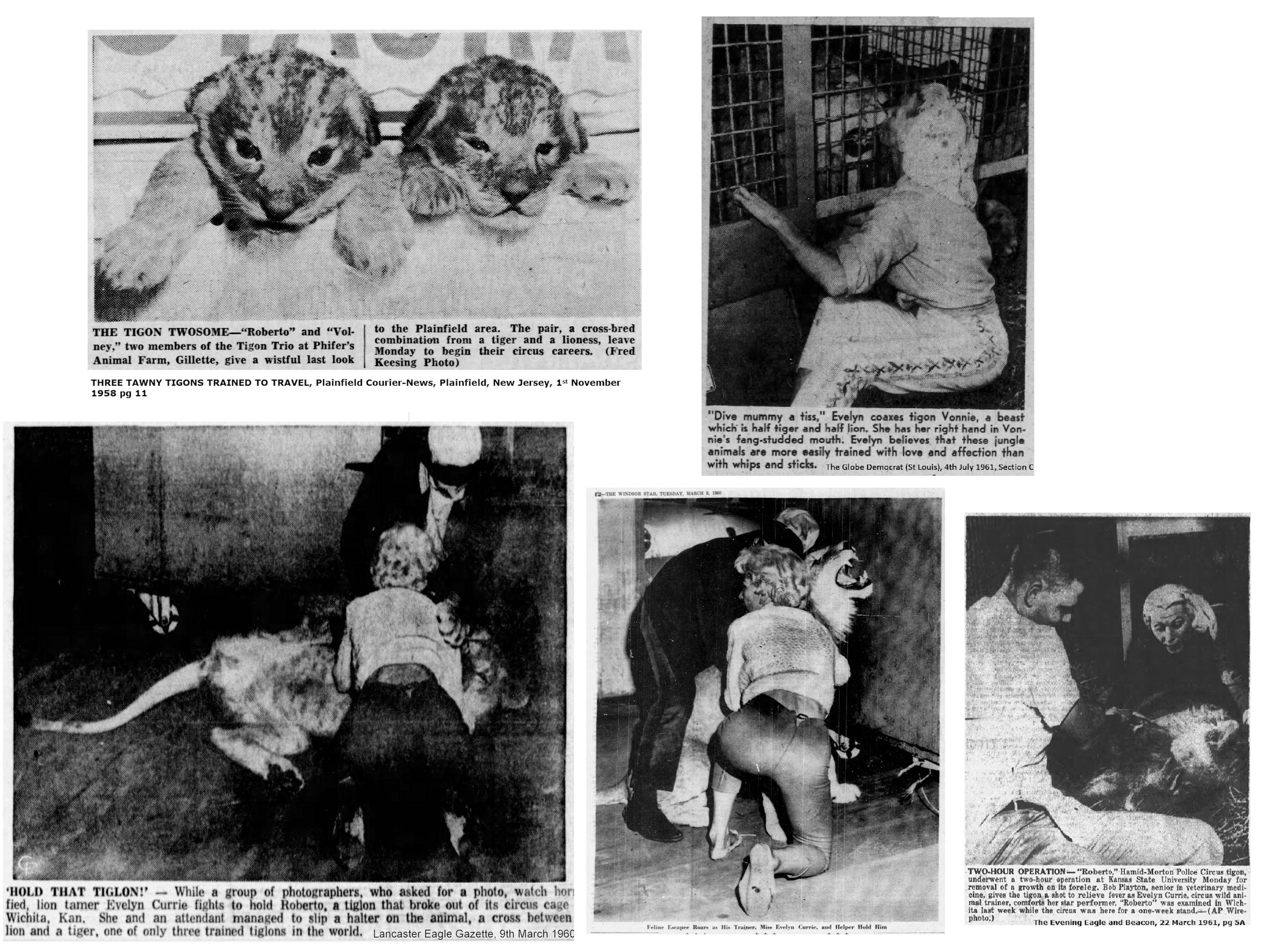
LOOSE LION WITH TIGER S TEMPER PUSHED BACK INTO HIS CIRCUS DEN. Intelligencer Journal (Lancaster, PA), 8th March 1960, pg 16. Wichita, Kan A 200-pound tigon half tiger and half lion got loose for a half hour in the Wichita Forum Monday. It happened when the tigon, Roberto, was allowed to stick his head through a raised portion of his cage to pose for a photographer. Roberto lunged forward and wriggled through the opening. The photographer and other Wichitans scattered at the warning cry Lion loose. The trainer, Miss Evelyn Currie, and helper in her lion and tiger act in the Hamid-Morton Circus, cornered Roberto first, bare-handed. The helpers set up around thin sections of the steel arena in which the act performs, and Roberto was persuaded to re-enter his cage. No-one was hurt.
TRAINER HAS TO WRESTLE IN UNSCHEDULED MATCH. St. Joseph Gazette, St. Joseph, Mo., 8th March 1960. Wichita, Kan. A lady and a tigon grappled in a circus arena Monday and the lady won as 50 terrified spectators watched. The 250-pound beast, described as a cross between a tiger and a lion, by its trainer, had bolted from its Cage during a picture-taking session for newspaper photographers.
Miss Evelyn Currie, 29-year-old animal trainer for the Hamid-Morton Circus, was the heroine in the impromptu circus act which occurred several hours before the regular show opened here Monday night. I was never more frightened in my life, the petite 115-pound trainer said after the 30-minute wrestling match with the tigon, Roberto.
The whole thing started when photographers pressed Miss Currie for an unobstructed view of the animal for their lenses without having the bars of the cage interfere. She opened the door, planning to throw a halter around Roberto, then lead him to the entrance where the photographers could have a clear shot. But Roberto, sensing a chance to get away, darted out the door and into the arena. Miss Currie was right behind and jumped on the animal s back.
I yelled to those standing around, Don t run or he'll go after you, Miss. Currie said. She suffered a scratch on her shoulder in subduing the tigon and holding it while circus attendants slipped a restraining noose over its head and led it back behind bars.
According to the Alexandria Daily Town Talk, Alexandria-Pineville, La of 8th March 1960, pg 18 Woman Trainer Wins Battle With Escaped Circus Tigon, Currie knew there were policemen around with pistols as was afraid they would shoot the escaped tigon, which was extremely valuable.
TIGON STAR OF WICHITA S POLICE CIRCUS UNDERGOES LEG OPERATION AT MANHATTAN. The Evening Eagle and Beacon, 22 March 1961, pg 5A. Roberto, the Hamid-Morton Police Circus tigon who was given an X-ray examination here last week, underwent an operation at Kansas State University s veterinary hospital this week . . . for removal of a large growth on its left foreleg . . . The growth, according to Miss Currie, had been present on the tigon s foreleg since birth. As it grew larger it gave the star of the show trouble. It was aggravated with injury in two recent incidents at Toronto, Canada, and Milwaukee, Wis. [Roberto injured himself when he tore up a car interior and tore down part of a circus tent.]
SOMETIMES THESE PETS PLAY A LITTLE ROUGH. The Globe Democrat (St Louis), 4th July 1961, Section C. Evelyn Currie and her lions, tigers and tigons (half lion; half tiger) are a featured act in the Shrine Circus which may be seen at Public Schools Stadium through July 5. . . . Evelyn picked up a heavy stick and banged it against Vonnie s cage again and again. Vonnie is a tigon. Pasha [lioness] is his mother. Napoleon, a tiger, is his father. Vonnie blinked while the banging was going on. The Evelyn stuck her hand through the bars of the cage and Vonnie brushed it with his cheek. Evelyn said that proved her animals know she won t hurt them.
The following account of a cub in 1961 cannot be accurate as Roberto had been born in 1958 and would not have been a baby in September 1961. Female tigon Tanya was born in 1961, so it s likely the journalists mixed up the names.
EVELYN CURRIE ANIMAL TRAINER HAS PINT SIZED TIGON IN RETINUE, Chattanooga Times, Tennessee, 20 Sept 1961, pg 17. A baby tigon, half tiger and half lion, is the latest addition to the retinue of Evelyn Currie, a Chattanoogan who is featured as a lady animal trainer with the Shrine Circus . . . She claims the tigon, named Roberto, is very rare and one of the few of its kind in the world. Now a puppy-sized, eight-week-old cub that takes a bottle (and must be burped) like a baby, Roberto is valued by his mistress at $36,000. She expects the striped and spotted ball of fur may someday weight around 600-700 pounds and worth much more. Roberto, named for Mis Currie s husband and partner, will make his professional debut at Warner Park Field House at 7:30 p.m. Oct. 5 when Miss Currie performs with her lions and tigers for the benefit of the Glenwood School Parent Teachers Association.
According to some reports Currie had a tiglon called Tillie (also known as Angel), born in 1961, the date also given for Tanya in later reports. All the reports agree that Currie had only one tigon/tiglon at that time which means Tillie must have become Tanya later on.
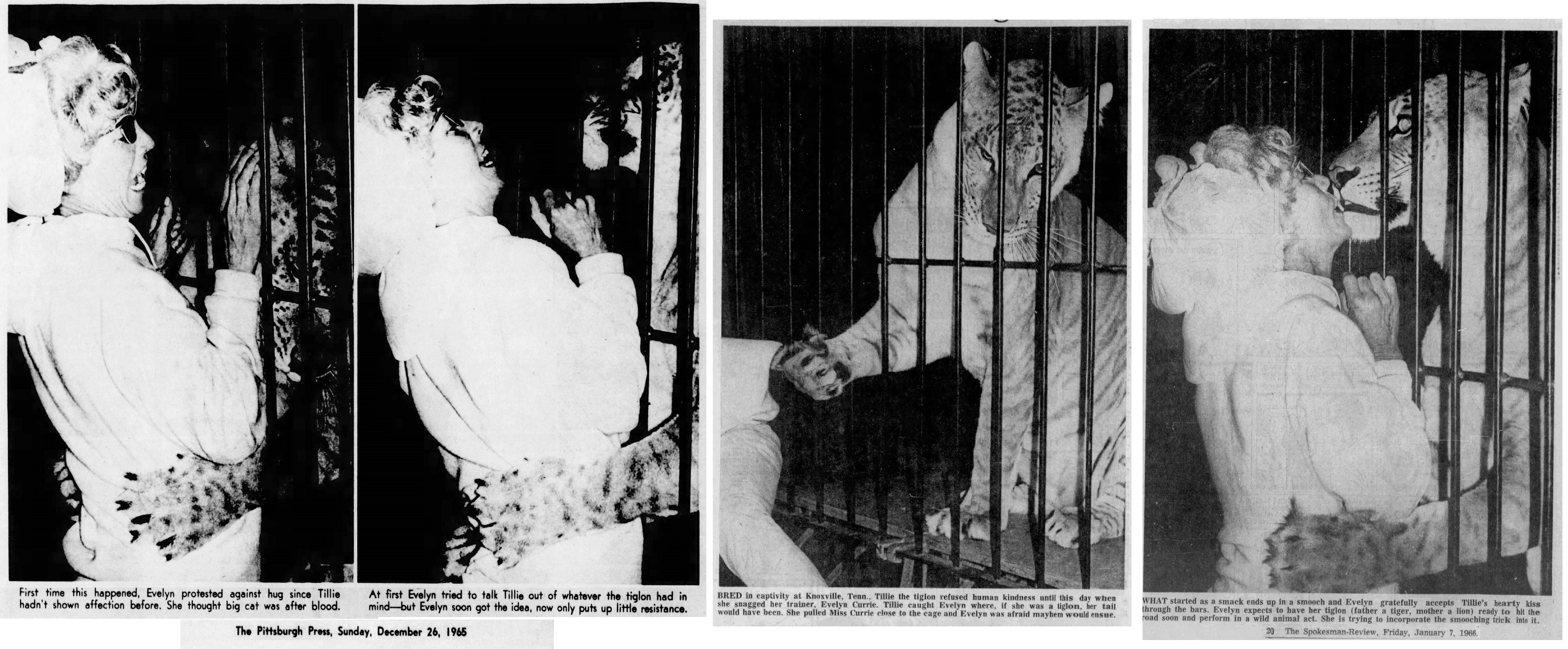
The Times-Dispatch (Richmond, Virginia), 14th July 1963, pg 8-H, described the one and a half year old Tillie as being born to lioness Pasha, sired by tiger Napoleon. She was believed to be the only tiglon in existence, although Salt Lake ity Zoo had a liger. Evelyn referred to Tillie as Angel and said she had a lion head and tiger body. According to the Pittsburgh Press (Pennsylvania), 26th December 1965, pg12, Though bred and raised in captivity, Tillie the tiglon never showed an affectionate streak until she was nearly five years old. Owner-trainer Evelyn Currie, who manages a touring wild animal act, tried to domesticate Tillie in training quarters in Knoxville, Tenn. But Tillie would have none of human kindness until one day she reached a paw through the bars of her cage, snagged Miss Currie s jacket and pulled her close. Miss Currie feared mayhem would ensue. Instead she was rewarded with a kiss, after being pulled right up to the cage bars. Evelyn expects to have her pet tiglon (father a tiger, mother a lion) ready to hit the road soon and to perform in the act. The kissing will be in the show. In 1966 Tillie, was exhibited at Dietch's Zoo in Fairlawn, New Jersey. Tillie became Tanya around this time as Evelyn Currie became Jody Clay (aka Jody Christy) following career-ending injuries.
According to the Tampa Tribune, 25th November 1971, Dade City s Carnival Days Under Way with Varied Fare, the show included a rare animal known as Tanya the Tigon The tiger-lion is one of only four in the United States and less than ten in the world, according to her attendant Miss Jody Christy [one of Evelyn s pseudonyms]. She s like a two week old baby at heart. Unlike most animals in show business, Tanya never worked for money and was paid 20-lb of raw meat per day. She had been featured in major magazines. According to Miss Christy Walt Disney tried to buy the animal from her some years ago but was not interested in hiring her to care for Tanya. I just couldn t sell her she would die without me to care for her.
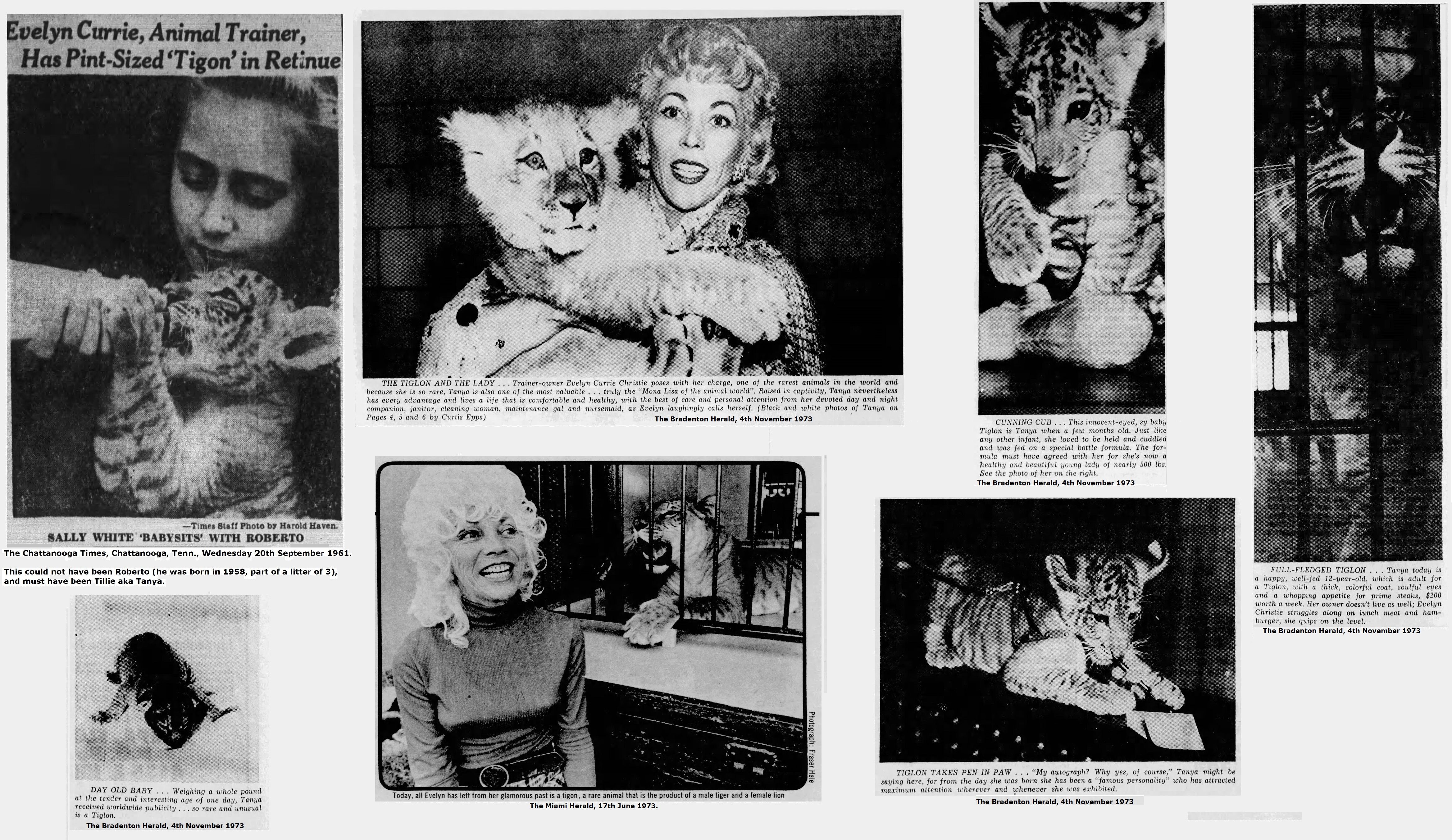
In 1973, The Bradenton Herald Sunday Magazine, 4th November 1973, ran a multi-page article on Evelyn Currie s (aka Evelyn Christie) tigon Tanya entitled MONA LISA OF THE ANIMAL WORLD. Tanya lived in Sarasota, Florida. It told us that Evelyn Currie s 12-year-old Tiglon, Tanya, had the most beautiful fur coat in the world and that Tanya s parents were a lioness and a Sumatran tiger, both wild-caught [ forest-bred ]. Tanya was the tawny gold colour of her lioness mother, with pure white fur on the belly and the stripes of her tiger father, but the stripes were a mix of brown, gold, bronze, beige and black. Evelyn Currie estimated Tanya s coat to be worth at least a million dollars. Tanya s lioness mother was 12 years old when Tanya was born and previously had a number of stillborn Tiglon cubs. Tanya was put on a carefully monitored diet to ensure her survival.
By 1973, Tanya was 450-500 pounds and ate chopped steak, 24 egg yolks, and one can of Carnation milk, some cod-liver oil, plus 15 to 18 lbs. of top grade beef roast and steaks daily. It cost $200 a week to feed her and the animal s value meant the food had to be screened for any impurities, sprays, insecticides or other foreign matter which could have an adverse effect on the Tiglon. Currie did all the maintenance an cleaning work herself because Tanya was too valuable to trust the work to anyone else. She had to be careful of is germs being brought in from outside.
The Tiglon was over eight feet long from the top of her head to the tip of her tail now, and her feet were more than six inches wide. She was born in a granary on the Chapin farm in Bangor, New York, Tanya had been in the limelight since birth. Over 20,000 people invaded the small town that morning just to get a glimpse of her, according to Currie. They had been en route to do a circus show and the mother went into labour. The wagons had to have police protection so nothing would happen to the precious cub. Tanya was so valuable that Currie slept alongside her in motel basements when travelling, fearful of pneumonia from motel air-conditioning systems or exposure germs. Once, in the New York Coliseum, the heaters were turned off and the temperature fell from 80 Fahrenheit to below zero an the circus called out the union, the police, and the humane society to get the temperature back to normal. Fearing this could cause pneumonia, Currie took Tanya to a doctor.
Tanya always went directly from the large bus, bearing her name, which was her home to a smaller van which transported her to and from public appearances. She was never allowed to touch the ground for fear of picking up germs or insect pests. Tanya was also usually given boiled water because some bad water almost killed her one time. Sometimes Tanya was too playful and hurt Currie, who said she didn t regard herself as an animal trainer because Tanya was the real boss. [It was reported in Animal of the Week in various paper on 25th November 1973 that Tanya got 2 soap and water baths each day.]
Evelyn Currie (later Evelyn Christie) was a colourful character. The Miami Herald, 17th June 1973, printed her life story. She was born Evelyn Clark, daughter of a Swiss mother and a Cherokee father. Her mother kept the family on the move to avoid their debts. At age 7 Evelyn danced to entertain her mother s lodgers and at age 13, she ran away to join a carnival. At 16 she was shoplifting fruit and raiding dustbins and became the youngest madam in Miami. In the 1930s she was the star witness in a white-slavery trial. She married Al Youst so she didn t have to testify against him after his club was raided by the FBI, and she bore him a son. She was sentenced to serve 4 years in federal prison, the youngest woman at Aldersen, W. Va., federal penitentiary. When her mother took Evelyn s year-old son to visit, the boy fled from her. Aged 20, she was paroled and went to work as a lab technician at Pine Breeze Hospital, Chattanooga, Tenn. She witnessed corruption and malpractice there and her information led to the hospital being investigated. By age 22, she finished her parole. Her son would have nothing to do with her.
Evelyn went to Detroit where she met a carnival-owning millionaire. She learned the carnival business, but became lonely because of the travelling lifestyle. The couple were later joined by Henry Currie who learned the carnival business and who married Evelyn. She had always wanted to own lions and tigons and began to buy big cats which she kept at a New Jersey zoo. When Henry Currie gave her an ultimatum him or the big cats - Evelyn chose the big cats, but they would now have to earn their keep. It was 1958, she was nearing 40 and her first show in Chattanooga, with 13 big cats, was disastrous. The animals were not used to the circus arena and she was mauled by a tiger called Napoleon and then by a lion. She continued to work with her beloved big cats, sleeping alongside them and trusting no-one else with them. They were better fed than she was. Desperate for help Evelyn married an Argentine.
[Tigons Roberto, Maria and Volney [aka Vonnie?] were born in 1958. March 1960 was when Roberto escaped from his cage. In 1961 there was a new tigon cub apparently also called Roberto, but this was the year Tanya was born at Bangor, New York State.]
In 1963, 41 year-old Evelyn was injured in a performance and could no longer perform. Over the next year all but one of her cats died from an infection picked up from their straw bedding. Evelyn herself became ill. Around that time, the media had uncovered her real identity as an ex-convict. The only survivor of infection was a tigon, born the previous year in New York state [Tillie]. To keep her tigon safe, Evelyn became Jody Clay, not a performer, but the tigon s cage girl, and Tillie became Tanya. She travelled with the tigon from the 1964 World s Fair through a series of shopping centre and carnival appearances. If spectators asked cage girl Jody if she d ever met Evelyn Currie, who used to have a tigon, she d reply that she had known Evelyn and that Evelyn was dead. She married animal handler Danny Christie and they eked out a living transporting wild animals for anyone who would hire them. She was offered thousands of dollars for the tigon but would not sell it When the tigon goes, I die, she d say.
In 1973 the couple were broke and Evelyn planned to take another identity and make a living performing with the tigon. She also considered hiring out the tigon for advertising, and turning herself into a carnival freak. The couple shared a converted school bus with Tanya the tigon and Evelyn was understandably paranoid about germs. She seems to have made some money from showing Tanya and from interviews. Evelyn died in 1991.
1930s - 1980s VARIOUS TIGONS
Anyone who is able to acquire and keep big cats can potentially breed hybrids. Most are now bred by private menageries as attractions or performing animals. Reputable, conservation-minded zoos no longer breed hybrids. Tigons are less common than ligers because they rarely reach impressive sizes. These are some of the more recent tigons in captivity, but this is not intended to be a tigon directory and I m no longer adding to it as I don t want to encourage the breeding of hybrids.
In November 1932, there were reports that Fleishhacker Zoo, San Francisco, were ready to breed tigons: Nepal and Skippy are pals but by all the laws of the jungle they should be natural enemies, or to fight to the death. But Nepal and. Skippy are too young and too far from the haunts of their ancestors to know the rules of etiquette governing relations of lions and tigers. They ve known each other since they were babies, and have been roommates, out at Fleishhacker s zoo since Skippy was weaned from her bottle. And today, Nepal, 7-month-old tiger, is the boyfriend and boon companion of the half grown lion, six weeks his junior. Director George Bistany of the zoo hopes their childhood friendship will blossom into romance and perhaps lead to the origin of a new species. But just what this new animal would be like, Bistany declines to guess, except that it would be some strange mixture of Asia and Africa such as the world never has seen.
Maybe part striped like a tiger, and tawny colored like a lion, he suggested. So far as I know a lion and a tiger have never been mated. In their native haunts they don t meet. You can t mate captive adults. They d fight. Probably kill each-other. The only way you can do it - if you can do it at all - is to bring them up together from babies. Bistany has raised his pets from birth. Both were born in the zoo and reared on a bottle. Orphans, you might call them. Their mothers, as the captive big cats so often do, refused to nurse them. Skippy s sister was killed by her mother. So Bistany raised them on cow s milk. When Skippy was old enough he put them together, and they hit it off right from the start. Such rare progeny - born before in a German menagerie - are known as tigelions if the father is a tiger, " ligers if the father is a lion.
BEATTY TO BAR TYRONS IN 1937 BIG CAGE ACT, The News-Sentinel, 2nd January 1937
Clyde Beatty, the 135 pound wild animal trainer, will not show "tyrons" in his circus or his moving picture this year. The "tyrons" he said, are crosses between lions and tigers, but Beatty found them "disappointing." The two he sought died in Munich before he arrived there, but they would have been valueless for motion pictures, anyhow, because their stripes are too indistinct to register on films. Only three of the strange hybrids have been born. The third is still alive at the Berlin zoo.
The Saturday Evening Post (advertised in The Kansas City Star and The St-Louis Post Dispatch, both of 10th May 1938): WILL 1938 DECIDE BRITAIN S FUTURE IN INDIA? There are two Indias one ruled by native princes, one by British governors. Can Britain ever unit them? In The Tigon and the Lyger, John Gunther tells you why this year may decide. This was also advertised in the London Evening Standard, 16th September 1938 as appearing in BRITANNIA and EVE.
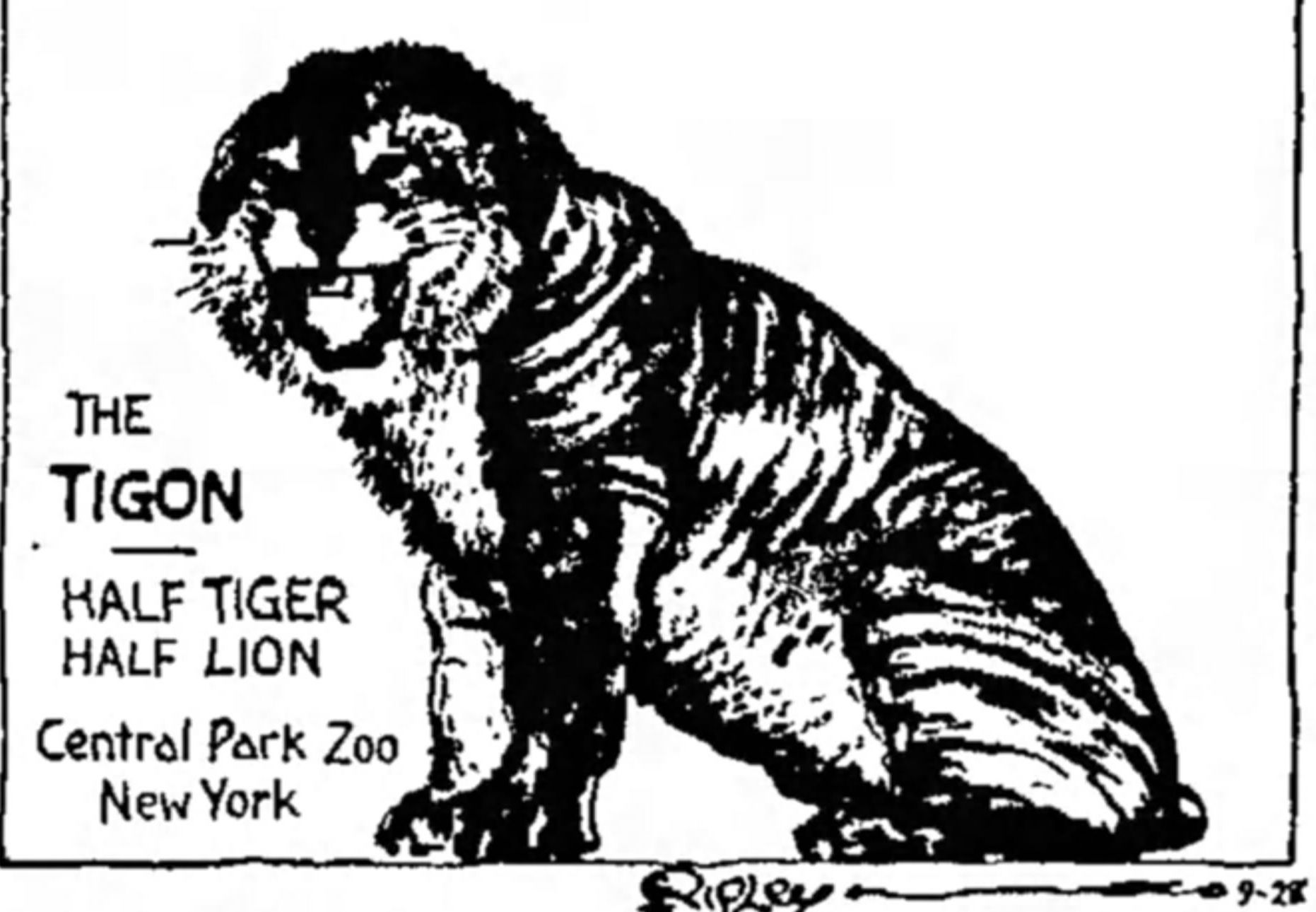
In 1938, a tigon was exhibited at Central Park Zoo. This was reported by several papers: A liger or tigon or lioger or tilion or well, an odd-looking beast, aged 4, with a puzzled look on its face and a glint in its eye romped in solitude Saturday in a cage in Central Park (NY). Where he came from only the directors of the zoo knew. The donor, they said preferred to ream anonymous and they were not going to let the cat out of the bag One thing was made public - papa was a Siberian tiger; mama was an African lioness, and the offspring rare, resembling a lion save for its head. But New York s surprise is still to come: In winter when the pelt is in its prime the stripes appear. And also THE TIGON. One of nature's strangest hybrids, a 4 year old cub of an African lioness and a Siberian tiger, is the latest resident of the Central park zoo in New York City. The animal, known as a tigon, resembles a lion with the exception of the head, but its ears are striped like a tiger's, and in winter time, when the pelt is in its prime, the body shows the tiger s stripes. The animal had been bred in the Hamburg, Germany, zoo, and is the gift of an anonymou- donor. The head keeper of the zoo explains that when the tigon resembles a lion more than it does a tiger it is known as a liger.
The Central Park Zoo tigon was already four years old in 1938, a "four year old cub of an African lioness and a Siberian tiger" (they used cub in the sense of offspring ), born in Hamburg Zoo and was a gift to the Central Park Zoo.
TIGON. The Central New Jersey Home News, 4th September 1938. Gaping crowds at New York s Central Park Zoo now are permitted to see one of the world s rarest animals. It s a cross between a lion and tiger, called by zoo officials a tiglon. It was given to the zoo by an anonymous donor. Over in London the zoo has much the same thing, only it s called a tigon. There is no mystery about where that one came from. It was presented by an Indian maharajah. It seems the Indian potentates for years have bred the animals as a hobby. But cross-breeding between lions, tigers and other beasts is not limited to India. One of the first tigons or what have you ever exhibited publicly was bred was bred by the late Karl Hagenbeck, German circus impresario.
The Nanaimo Daily News, British Columbia, 9th January 1939, page 2, reported The New York Zoo has a tigon, which is the hybrid child of a Siberian tiger and an African lion. (It seems apparent that the tigon in the Central Park Zoo was the brother of the Manchester Zoo tigons.)
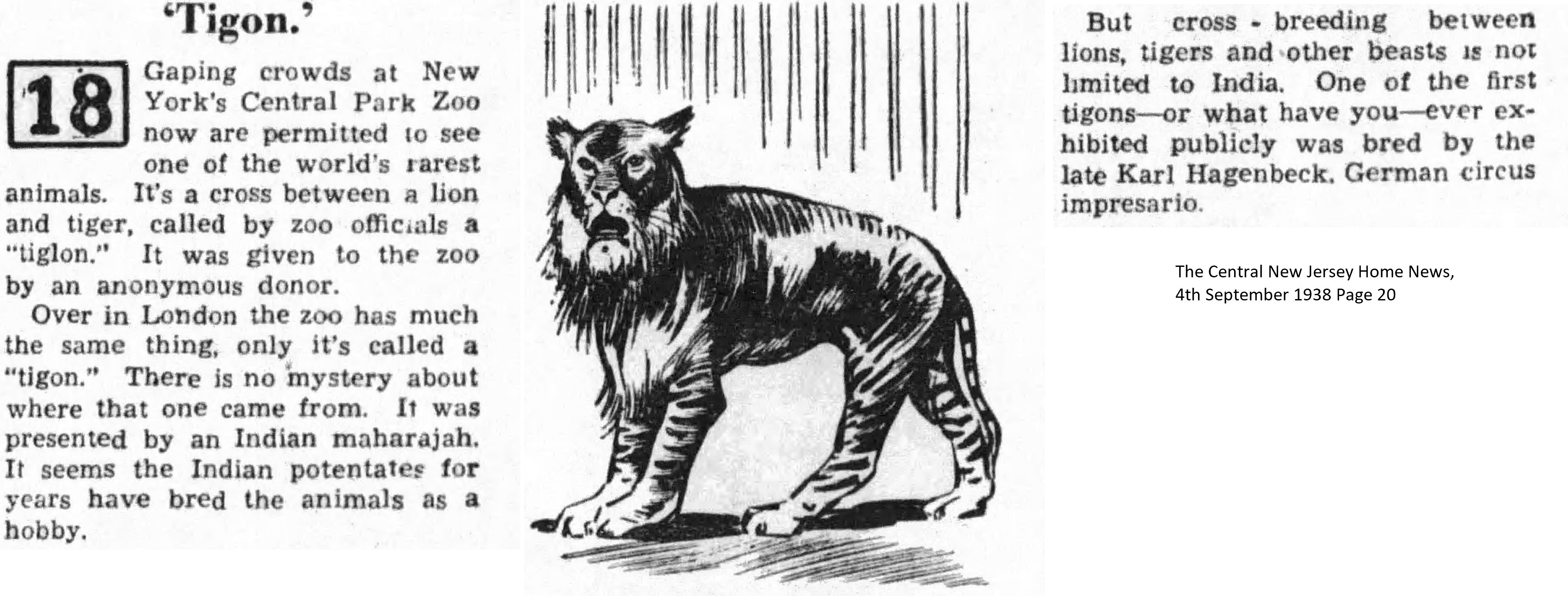
FOREST ZOO TO TRY MATING TIGER AND LION GET TIGONS. Fort-Worth Star Telegram, 21st November 1939, page 18: The twang of a bowstring will have no part in the proceedings this week when Zookeeper Hittson plays Cupid for Roger [Rajah], a Bengal tiger, and Martha, a Nubian lioness, at the Forest Park Zoo. Instead the introduction of Roger and Martha may be accompanied by the pounding of dishpans and blowing of whistles.
A lioness and a tiger usually won t mate, Hittson explained Monday, but we re going to try Roger and Martha. If we re lucky we may have some little tigons. Then he explained about tigons. They re offsprings of a lioness and a tiger or vice versa and comparatively rare.
The dishpans and whistles will be handy in the event the two animals fight when they are placed in the same cage. If a fight should start, the noise will stop it, Hittson believes. If the noise doesn t succeed water from a hose should. The only purpose of the experiment is to attempt to match accomplishments of the London zoo and two in the United States. They have acquired tigons by similar experiments. Hittson believes the presence of one or two tigons would lift the prestige of the Forest Park Zoo considerably.
FORT WORTH ZOO PLANS MATING OF TIGER AND LION. Fort-Worth Star Telegram, 21st November 1939, page 18: Rajah, a tiger, and Martha, a lion, have been making eyes at one another for six months through the wires separating their cages at Forest Park Zoo. Zookeeper Hittson, ever willing to play Cupid, decided Monday to put them together as they have been getting along as neighbors well the result may be some little tigons. Tigons are the offspring (very rare) resulting from the mating of tigers and lions. The London zoo and two zoos in the United States have acquired tigons by similar experiments.
RAJAH AND MARTHA AT HOME AFTER BREAKFAST DISPUT, Fort-Worth Star Telegram, 7th December 1939, page 20: Rajah, the Bengal tiger, and Martha, th Nubian lioness, were at home Thursday in a Forest Park Zoo cage after an uproarious honeymoon breakfast that brought out the worst in each of them. Rajah and Martha were placed together at the order of Zookeeper Hittson, who hopes for a romance and a litter of tigons. Hittson is fascinated with the idea of having one or more tigons at the zoo because, if there were any of them around in Pilot Noah s time, they missed the boat. So far as Hittson knows, the only tigons in existence are those which were raised in London zoo and in one or two zoos in this country. A tigon here, he points, would boost the rating of the zoo.
Early Thursday morning Hittson and the zoo attendants opened the gate between the two cages occupied by Rajah and Martha. Each, after having evinced interest in the other during the past week, eyed the opening with some suspicion. The Martha, throwing all false pride to the winds, went to Rajah and the gate behind her closed. They eyed each other, then began stalking at opposite sides of the cage. They were at the point of ignoring each other when breakfast in the form of several pounds of raw meat was served. Martha took charge and Rajah sulked. Martha dared to turn with the meat in her mouth. It was then that they fell into each others arms but the embrace was not one of affection. Each was snapping at the breakfast when a hose was turned on them. Martha was forced back in her cage for the remainder of the breakfast, but after they had eaten they were placed together again. Harmony was ruling over the household at noon.
RARE HYBRID ANIMALS. The Emery County Progress, 27th June 1947, page 3 (and many other papers) reported One of the rarest hybrid animals is the offspring of a lion and a tiger, there being no more than six in captivity today. When its father is a tiger and its mother a lioness, it is called a tigon; and when its father is a lion and its mother a tigress, it is called a liger.
In July 1998, the Indian Express Newspaper reported the approaching death of the country's last known surviving zoo tigon. Ranjini, born in 1973, resembled a lioness in size and shape, but with a slightly smaller head and jaw and a brighter yellow coat with faint tiger-like stripes. Ranjini, kept at Calcutta zoo, was bred from a Bengal tiger and an African lion and lived to the age of 25 years. There were only 2 known living tigons in 1976; both in Calcutta zoo: a 5 year old female named Rudrani and her 3 year old sister Ranjini. The zoo's first tigon was Rudhrani, born in 1971, was mated to an Asiatic lion called Debabrata and produced 7 li-tigons in her lifetime. Some of these reached impressive sizes - a li-tigon named Cubanacan (died April 12th, 1991) was believed to weigh at least 800lb/363 kg, stood 52 inches/1.32m at the shoulder and 11.5ft/3.5 m total length (1994: GBWR "largest litigin"). However, Ranjini was not allowed to have a mate due to pressure to end the breeding of hybrids. The zoo was also discouraged by the problem of sterility in the male hybrids (in both tigons and li-tigons). The original tiger and lioness, parents of the two female tigons, had also died, ending the prospect of producing further tigons. In 1985, the Indian Government forbade the cross-breeding of lions and tigers following a campaign by the Worldwide Fund for Nature. This ended a long tradition of lion/tiger breedings in the country. These date back to 1837 when the princess of Jamnagar (an Indian state) presented a tigon to Queen Victoria.
When female tigon Noelle was born at Shambala in 1978, there were only 3 other tigons known in the United States (there might have been others in private hands). Apollo, a tigon at Moscow zoo, was bred from an Ussuri tiger. A tigon was kept at the Valley Of The Kings sanctuary in Wisconsin. Java, a male tigon, was 3 years old in 1998 and came from a farm in Mississipi to protect him from mistreatment, according to the JES Exotic Sanctuary (now Valley of the Kings) in Sharon, Wisconsin, about 100 kilometres west of Chicago. He was undersized at 375 lbs, but was still growing. Java the tigon was killed by lightning during a severe storm in 1999. According to Valley of the Kings (correspondence), there may be as many as 30 or 40 tigons in captivity in 2005, most being owned by private collectors who may have obtained them illegally and who do not advertise their existence. China's first tigon was born at Hongshan Zoo in Nanjing, Jiangsu Province, in 2002. It lived only one week.
1990s AND LATER - A FEW RECENT TIGONS
I AM NOT ADDING ANY FURTHER RECENT TIGONS TO THIS PAGE.
In December 2000, Australia's National Zoo in Canberra acquired a brother and sister pair of tigons. Asta (male) and Tangiere (female) had been bred accidentally in 1987 at a circus to a Bengal tiger and a lioness. They were hand-raised and spent their first several years at a private facility. In 1994, while the tigons were at Ashton's Circus, a toddler lost both his arms when he put them through the bars of the tigons' cage and was severely mauled by Asta. The tigons were 7 years old. The resulting claim stated that the tigons had been placed in an inappropriate area that was a clear attraction for children. There was no safety fencing and the perimeter was not properly supervised. The circus also lacked safe and proper procedures for the housing and exercising of the tigons. Because the facility did not provide adequate quality housing, along with its lions and tigers from the facility, the tigons were moved to the National Zoo. In spite of a "no hybrids" policy, the Zoo took the tigons on humane grounds because there were few other options for the pair.
At almost 20 years old, Asta and Tangiere were healthy, having been overweight when they arrived at the Zoo (Asta died in 2008 of old age). They occupied a large enclosure with log climbing frames and a moat in which they sometimes paddle. They ate about 4 kgs of beef, horse, kangaroo, goat, rabbit and chicken per day, excepting 2 "starve" days to mimic the normal lifestyle of big cats (not all hunts are successful). Asta weighed approx 160 kg (around the same as a large adult female Bengal tiger, but small for a male). Tangiere weighed 145 kg (average for an adult female Bengal). They had been housed together for their entire life and mated regularly when Tangiere was in season. Due to the sterility of male tigons, no offspring were produced. Although the tigons were popular attractions with visitors, the Zoo has no plans to breed further hybrids or to mate Tangiere to either a lion or tiger to ascertain whether she is fertile.
A female tigon named Simba appears to have been born in Lucknow in 2001.
In August 2001, Shanghai Safari Park had 4 tigon cubs from an accidental pairing of African lioness "Huanhuan" and Siberian tiger "Huihui". Unfortunately, none survived. The two male and two female cubs' legs and necks resembled their mother, but their faces and tails were tiger-like. The front part of their bodies were lion-like and the rear part tiger-like. The parents were both 3 years old and are stars of the park's animal troupe. The lioness was in her mating season when the troupe was on a out-of-city tour and chose the tiger as her mate. The 4 dead cubs will be preserved as specimens and put on display. In May 2005, 2 tigons and 3 ligers were bred at the Shenzhen safari park, Guangdong province, in southern China (near Hong Kong). The two tigons at Shenzhen safari park were born to lioness Ming Ming and tiger Su Min. The report said that tigons did not live much beyond 3 months weeks because of the genetic abnormalities. The previous record for the oldest tigon in China was just under four months.
In 2009, twin tigons were born in Hainan Tropical Wildlife Park and Botanical Garden in Haikou, south China's Hainan Province. The parents were a male Manchurian tiger and a female African lioness. At the time there was also a tigon at Xiamen, Fujian province. A pair of tigons were born in Yancheng Safari Park of Changzhou city on December 26, 2011. The female tigon cub died soon after its birth. According to the safari park, tigons have a low survival rate, close to 1 in 500,000.
In April 2005, a "tigron" (which was actually a liger!) called Samil was born at the Italian Circus in Vigo, northwestern Spain. Samil is a cross between a female tiger and a lion and therefore is a liger. A tigon was born in the Korona Circus in Podolsk, Moscow, posted on August 8, 2016.
The Nahargarh Rescue Centre in the Nahargarh Biological Park, Jaipur, India is home to many rescued circus big cats, including a tigon, but under the rules of the Central Zoo Authority (CZA) it could not exhibit them to the public they had suffered enough as public spectacles. Simba, the tigon, was rescued by PETA from the Empire Circus in Mumbai.
G Peters included several hybrids (liger, tigon, leopon, leguar) in his "Comparative Investigation of Vocalisation in Several Felids" published in German in Spixiana-Supplement, 1978; (1): 1-206.
As at 2021 there were 12 in the US, several in China, probably 4 in Iran, 2 in UAE, 2 in the Philippines, 1 in Russia, possibly 1 in India, 1 in Sarasota, and probably some in Czechia and Argentina. The Czech Republic has a big problem with privately owned big cats as does the United States. There is a brother and sister pair in the royal palace in Dubai, one of which closely resembles a faintly striped lion, so it is probably a second generation hybrid e.g. liger mother x tiger father. It seems likely they bred only a single litter there, kept two, and gave the others, along with several ligers, to a safari park in the Philippines (Zoobic Safari, Subit Bay?). The President of UAE (at the time of writing this in 2021) bred ligers, tigons, white tigers and white lions and sent his surplus animals to the Philippines.
I AM NOT ADDING ANY FURTHER RECENT TIGONS TO THIS PAGE.
LIGER & TIGON COLOURS
White tigers have been crossed with lions to produce white ligers. Everland Zoo (Yongin Farm Zoo) in Seoul, Korea has produced white ligers, possibly from white tigers and leucistic lionesses. Big Cat Rescue's white tiger apparently co-habitates with a lion, as it was the intention of the original owner to breed white ligers. Golden tigers have been crossed with lions to produce golden ligers. In theory white tigers could be crossed with white lions to produce truly white ligers. White tigons or golden tigons are also possible, but because tigons do not attain the huge size of the liger there is far less interest in breeding them.
A black liger would be an impressive creature, but to breed one would require both a melanistic tiger and a melanistic lion because the gene for black must be inherited from both parents and to guarantee a black liger requires both parents to be black. Very few true melanistic tigers have ever been recorded. Most "black tigers" are due to pseudo-melanism i.e. the markings are so heavy that the tawny background colour is almost hidden. No reports of black lions have ever been substantiated.
In felines, "blue" means a slate-grey colour. Genetically, it is a form of melanism where the colour has been diluted from black to grey. To breed a blue liger would require a blue (i.e.grey) tiger and a black lion (or black tiger and blue lion. Or blue tiger and blue lion). Blue tigers have been recorded in China, but none have occurred in captivity. To date, no grey lions have been recorded.
FOOTNOTE
The practice of using dogs to foster lion and tiger cubs, and then to keep the full-grown big cat company in a menagerie gave raise to some strange claims of hybrids:
SUPPOSED HYBRID BETWEEN A LIONESS AND MASTIFF (The Field, 29th November 1862). An account of a monstrosity, in the shape of a hybrid born of a lioness and a mastiff, both said to belong to Captain Patten-Saunders, appeared in Bell s Life of Nov. 16. Can Mr Rockland or any of your correspondents give us any information about this wonderful novelty? It would be most interesting to hear something more about it. C. M. M. (Sime, Beds.)
WHY ARE LIGERS SO MUCH BIGGER THAN TIGONS?
REFERENCES AND FURTHER READING
Historical accounts of ligers and tigons (chronological order): CJ Cornish et al (undated), R De Davison (1863), K Ackermann (1898), A R rig (1903), Deutshe Landwirtshaftliche Presse (1904), Boettger (1906), T Noack (1908), A Sokolowsky (1909), H Przibram (1910), SS Flower (1929), L Reisinger (1929), Sir PC Mitchell (1930), H Heck (1932), RI Pocock (1935), CWG Eifrig (1937), WA Craft (1938), L Heck (1941), VG Stefko and VP Narskii (1946), B E (1946), American Fur Breeder (1948), Illustrated (1948), H Pilcher (1948), B Grzimek (1949), A Urbain and J Rinjard (1950), P Leyhausen (1950), C Hagenbeck (1951), O Antonius (1951), H Petzsch (1951, 1956), M Burton (1952), A Kemner (1953)< Farmer's Weekly Bloemfontein (1953), F Petter (1955), H Hemmer (1966, 1968), International Zoo Yearbook (1970, 1971)
Guggisberg, C. A. W. 1975. Wild cats of the world. Taplinger Publ. Co., New York
Leyhausen, P. 1950. Beobachtungen an L wen-Tiger-Bastarden mit einigen Bemerkungen zur Systematik der Grosskatzen. Z. Tierpsychol., 7:46-83.
Robinson's Genetics for Cat Breeders & Veterinarians 4th Ed (the current version)
Textual content is licensed under the GFDL.
|
BACK TO HYBRID & MUTANT BIG CATS INDEX |